POSTED: 10 Dec 2023

How Long Does it Take for Tretinoin to Work? Here’s A Week-by-Week Guide on What to Expect
Tretinoin is one of the best known topical skincare medicines throughout the world. This prescription-only-medicine is one of the most powerful treatments that we have for tackling acne, skin ageing, texture and evening out skin tone. The internet and social media are full of testimonies of transformative skincare journeys with Tretinoin. Each one extolling its ability to give clearer, brighter and more youthful skin. However, what’s less spoken about is the process and timeline needed to achieve these gains. In this article we answer one of the most common and least well answered questions in skincacre; how long does Tretinoin take to work? We’ll walk through the typical Tretinoin timeline and provide a week by week guide yo what to expect when starting Tretinoin.
What is Tretinoin?
Tretinoin , also known as all-trans retinoic acid or retin-A, is a derivative of Vitamin A and available by prescription only in countries like the UK . It belongs to the family of retinoids which include over the counter ingredients like Retinol and Retinal as well as prescription products like Adapalene , Tazarotene and Isotretinoin . Tretinoin is renowned for it’s ability to promote skin cell turnover and boost collagen production. Through these actions, it can treat acne and fine lines and wrinkles . Tretinoin is also effective in evening out skin tone and improving skin texture . Tretinoin is more potent than over the counter retinoids and as such is more effective and works more quickly than Retinol .
How Long Does It Take For Tretinoin To Work?
The time it takes for Tretinoin to work depends on your individual skin type, concern you’re trying to treat and the concentration of the Tretinoin you’re using as well as the rest of your skincare routine. That’s why it’s crucial to enter this journey with realistic expectations and a commitment to consistent use. This is because it takes time to see the benefits of Tretinoin which start gradually and build on with longer term use. Although each Tretinoin journey is as unique as the person on it, there are common milestones:
Initial Adaptation:
The first 2-6 weeks of using Tretinoin generally involve your skin getting used to it. During this time, it’s common to experience some skin irritation, purging , dryness and peeling. Although these are signs that the Tretinoin is starting to work not everyone gets them. Also, if they are excessive then you should contact your doctor as they may need to amend your protocol.
Visible Changes:
For acne treatment, some users may begin to see improvements in as little as 2-3 weeks. However, most people will see noticeable results after at least 6-12 weeks of consistent use. In terms of anti-aging benefits, such as reducing fine lines and improving skin texture or smoothing pores, the results usually take longer. You may need to use it for at least 3-6 months before you start to see visible changes. This is because Tretinoin triggers your skin cells to make more collagen which takes at least 6-8 weeks. The time it takes to start fading hyperpigmentation varies depending on severity and whether you’re using Tretinoin alongside Hydroquinone . Noticeable improvements in skin tone may start after as little as 6-8 weeks or as much as 3-6 months of regular use.
Full Benefits:
In general, the more you use tretinoin the more you will see the benefits. As a general rule, you may start to see peak effects after 6-12 months of consistent use. At this point, you may need to consider increasing the dose if appropriate. However, the good news is that you don’t become resistent to Tretinoin. Continuous use contributes to ongoing improvements in skin texture, ageing and tone no matter how long you use it for. It’s just that the rate and amount of improvement slows down.
Week-by-Week Guide of What to Expect on Your Tretinoin Journey
Starting your Tretinoin journey is exciting, however everyone’s experience is different. To make the most out of this treatment, you will need plenty of patience and persistence. However, the potential rewards are absolutely worth the wait! You can increase your chances of following through with Tretinoin treatment by knowing what to expect. Here’s a week-by-week guide:
- Preparation: The best way to start your Tretinoin journey is with a consultation with a doctor. They will assess your skin and design a personalised Tretinoin protocol to work for your needs.
- Adjustment Phase ( Weeks 1-2): In the initial weeks, your skin will be getting used to Tretinoin. Even at a low dose or frequency, you might still experience some redness, dryness or peeling. It’s crucial to maintain a gentle skincare routine during this phase and let your doctor know if there is any irritation or other concern.
- Purge & Progress ( Weeks 2-8): This period can see an uptick in breakouts as Tretinoin accelerates cell turnover. While disheartening, this is temporary and normal. Your doctor can help you get through this by adjusting your protocol.
- Weeks 6-8: Early Improvements Many users start to see some noticeable changes at this point. However, this does vary from person to person.
- Weeks 9-24: Assessing & Advancing Most users often report a noticeable reduction in acne and an improvement in skin texture as well as quality at this point. This is a good time to connect with your doctor so they can assess your progress and see if they need to make any changes to your protocol.
- Long-Term Results & Maintenance (From 24 weeks onwards): Tretinoin’s benefits continue to build up with with time. It is generally safe to use long-term provided you’re healthy, tolerating it well and not pregnant or breastfeeding. Consistency remains key to maintain and build on results.
Tips for Success & Reducing How Long Tretinoin Takes to Work
At the heart of using Tretinoin effectively is personalising the treatment to your needs and skin response. Whilst Tretinoin does take time to work (there’s no getting around this I’m afraid!), there are a few things that can speed up how long this takes. Below are some of our top tips for using Tretinoin properly :
- Factors Influencing Effectiveness: Although higher concentrations may yield faster results but also come with a greater likelihood of side effects. These side effects can damage the skin or set you back significantly. As such, the best strength and frequency to start on are the ones that your skin can tolerate without problems. This is why most people are better off on a low dose and slow frequency to get their skin quickly used to it. After that, it’s generally easier and faster to build up both the strength and how often you used it.
- Patience & Consistency: It’s important to stay patient and use Tretinoin regularly. Skipping applications or discontinuing use without good reason can delay or reduce its effectiveness and increase how long it takes to work.
- Get Expert Help: As with any prescription treatment, it’s really important to consult with a doctor for a personalised treatment protocol. They should also provide ongoing advice and aftercare to help you get the most out of your treatment.
Starting on a Tretinoin journey can be exciting and expectations are usually high! However, it is important to remember that this treatment needs commitment and patience. Also, individual experiences can vary, as can how long it takes for Tretinoin to work. This depends on your individual skin type, skin concern and how severe it is. You can maximise your chances of success by consulting with a healthcare professional for personalised advice.
At City Skin Clinic, we are passionate about personalised skincare. Our doctors offer safe effective treatments like Tretinoin and Hydroquinone through our online skin clinic. We treat a range of skin conditions including acne , hyperpigmentation , melasma and skin ageing . To start your personalised skincare plan, book a virtual video consultation or use our online consultation form . The journey towards great skin starts here .
Authored by:
Subscribe to our Newsletter
Please select all the ways you would like to hear from us:
You can unsubscribe at any time by clicking the link in the footer of our emails. For information about our privacy practices, please visit our terms of website use .
We use Mailchimp as our marketing platform. By clicking below to subscribe, you acknowledge that your information will be transferred to Mailchimp for processing. Learn more about Mailchimps privacy practices here.
You may also like
SKINCARE 11 March 2024
All the Different Types of Vitamin C Skincare & How to Find the Best One for You
CULTURE HEALTH SKINCARE 10 July 2023
What is Ozempic Face & What Can You Do About Ozempic Face Aging?
Connect with us
Start Your Online Consultation
The journey to great skin starts here. Start your online consultation for personalised prescription-strength skincare.
Welcome to FaceForward
Get the scoop on all things beauty, wellness, and skincare.
- Hyperpigmentation
- Skincare 101

The Tretinoin Purge Timeline: When and How It Happens
- By The Nava Team
- August 9, 2021
Tretinoin has fast become the gold standard for addressing troublesome skin conditions. From the signs of aging to severe acne, tretinoin administered the right way can have lasting, transformative effects.
But before you can experience the benefits that tretinoin has to offer, your skin may go through a process known anecdotally as the "tretinoin purge" or the "retinoid purge."
In this article, we'll take a chronological journey through the tretinoin purge process and some best practices to get through it. It's all in the pursuit of great, long-lasting results on the other side, and with an effective wrinkle- and acne-buster like tretinoin, it's worth it.
What is Tretinoin?
Tretinoin, commonly known by the brand name Retin-A® , is a prescription medication used to treat acne, wrinkles, fine lines, saggy skin, and dark spots. While Retin-A was the first FDA-approved version of tretinoin, it’s now available as a generic medication, and you’ll see it discussed more frequently as tretinoin than Retin-A.
Tretinoin is a retinoid , a class of molecules that are all a form of vitamin A, synthetic or naturally occurring. They all do roughly the same thing, but they each work a little differently, and some better than others.
“What about retinol?” you’re saying, “Isn’t that a retinoid?”
Bingo. Retinol, retinaldehyde, retinal, and tretinoin are all some of the more common retinoids. Retinol is one of the most common retinoids in over-the-counter (OTC) skincare or beauty treatments. It does not require a prescription, while tretinoin does.
Here’s the big difference between tretinoin and retinol. Where retinol needs to be converted into retinoic acid by enzymes in the skin, tretinoin is already pure retinoic acid in a concentrated form that starts delivering its benefits immediately, especially when combating acne. All of these medications work on a receptor called the retinoic acid receptor – you can see why you’d rather give your skin retinoic acid than something that takes a couple steps to get there.
There is a hurdle, however. Because tretinoin is retinoic acid, it can cause temporary redness, itching, and sometimes peeling when first applied. That’s the tretinoin purge.
Learn more in Nava MD's The Definitive Guide to Retinoids: The Best Wrinkle Creams
The Pros and Cons of Tretinoin
Tretinoin (and other retinoids) delivers its benefits in two ways:
- It increases cell turnover at your skin and prevents the clogging of pores that can lead to acne, blackheads, and other skin problems. Because increased cell turnover means that more fresh skin cells are created in less time, this also means that acne breakouts and blackhead frequency is significantly reduced for most people.
- Tretinoin can also boost collagen production and improve elasticity, and even reduce unwanted skin pigmentation.
While tretinoin is highly effective at combating acne and wrinkles in the long-term, the first few weeks can be challenging for some new patients. Some users of tretinoin will experience a "purge" during their first application, where their skin condition gets briefly worse before it gets better. Or, they may experience uncomfortable irritation, dryness, or redness. These challenges can range from the occasional whitehead to breakouts, and the purge can lead users to think they’ve made a mistake.
Patience my friend! Science has proven this treatment works over and over again, and success just comes down to a little bit of patience.
Why Does Tretinoin Cause a Purge?
Why does tretinoin worsen the very condition it’s designed to treat, and what exactly is going on?
The term “purge” is a bit of a misnomer. It’s tempting to imagine that your skin needs to rid itself of the substances that may be clogging pores: from oil and dirt to dead skin cells and bacteria. However, it isn't just ridding itself of these substances in the traditional sense of a purge. During this temporary phase, the skin is adjusting and preparing itself to help the new medication to work to its full potential. Remember, your skin is undergoing a more rapid cell turnover than it’s used to. All of the substances that were clogging your pores get pushed to the surface layer of your skin, and because things are happening at a faster pace, you may experience light inflammation, contributing to breakouts.
Frustrating? Without a doubt. Expected and necessary? Absolutely. You may experience breakouts in the usual areas, but you might also get pimples in new areas or a larger or lesser amount than normal.
Everybody's experience is different, but dermatologists agree: the most important thing you can do is trust the process and stick with it. The tretinoin purge means that the retinoic acid is working and that you are on the way to healthy, clear skin, possibly for the first time in years!
If you’re using tretinoin to treat the signs of aging, it’s still possible to experience skin purging even if you don't normally suffer from acne or breakouts. Again, put your faith in science and look forward to younger-looking skin.
When Does the Purge Start?
You can expect the tretinoin purge to start soon after your first application, usually within the first two weeks. However, the timeframe can vary. Some people can take weeks to experience skin purging, and it all depends on a number of factors, including skin type, skin condition, and the strength of tretinoin or retinoid you’re using.
For instance, retinol is a more gentle retinoid for most people. That’s why it’s in OTC beauty products – and why it doesn’t work nearly as well as tretinoin. Remember, retinol has to be converted into the active form, retinoic acid, at your skin.
Tretinoin is about 20 times more powerful than retinol!
How Long Does the Tretinoin Purge Last?
Once the tretinoin purge starts you'll naturally want to know how long it will last. You’ve probably already guessed that it varies from person to person. Some people may be lucky and only experience a purge that lasts for a couple weeks, while others might go through an adjustment period that lasts a few weeks to a month.
The good news is that it definitely does end – and that's when you start seeing results.
It's also worth noting that if you don't see any improvement to your skin after 3 months you should check in with your prescribing clinician. They may need to adjust the strength of the formula or the frequency of application.
Tretinoin Purge Waves: Why It's Not Always a Linear Process
As with many skin treatments, you may experience good and bad days during the tretinoin adjustment. Just when you thought the purge was over, along comes another wave and your skin starts to break out again. Don't worry if you experience this; it's all part of the process, and again, it will vary from person to person.
Remember that whether you experience the purge in one go or in waves, your tretinoin is doing exactly what it was designed to do.
How to Get Through the Purge
While you might not be able to avoid the purge altogether, there are things you can do to make the experience a little more pleasant.
Expect and Accept the Purge
By being prepared for the purge, you can accept it when it happens and rejoice if you’re one of the lucky ones who sail through the adjustment phase without a breakout. Instead of getting anxious about every new sensation (stress can also cause breakouts), count each pimple as a sign that the process is working.
Start Slow and Low
While you can't stop the tretinoin process if you want it to work, you can help to make the process less severe. By starting slowly at a low strength or with every-other-day treatment, you can reduce the side effects and the impact on your skin. Start off by using tretinoin once every two days or three days, and then progress to regular use as your skin gets used to it. Of course, that means you may not experience such dramatic results after your first application, but you can strengthen the dose to get even better results over time. In fact, your doctor may recommend a lower strength to start, or explain the side effects that come with a higher strength application if you want to go down that route.
Use a Niacinamide Treatment
Adding a product containing niacinamide can also help to alleviate the effects of the purge.
Niacinamide helps to reduce inflammation and brightens the skin, and it can work really well alongside tretinoin. Many people notice an immediate improvement in their skin tone when they start using niacinamide.
Keep Your Face Clean
Touching your face or allowing oil or bacteria to build up can also increase the side effects of the tretinoin purge. Only touch your face with clean hands and leave your skin to do its thing. Also try not to pick at flaky or dry skin caused by the purge. The dryness will dissipate over time.
Take Before, During, and After Photos
You see your face in the mirror every day but do you really see it? If you're feeling a little demotivated, take some photos before, during, and after the purge. You'll see that those improvements might be small at first, but that they are happening. Again, if you don't notice any improvements within 3 months, speak to your prescriber. Photos will also help your doctor to see the progress that you might not be able to see for yourself.
Use At Night
Use your tretinoin formulation at night before going to bed. There are two reasons for this.
First, tretinoin doesn't play well with direct sunlight. Harsh sun and heat can contribute to inflammation and make the purge worse.
Second, your skin does its best healing overnight while you're sleeping. By using tretinoin before bed you're giving your body and this medication the best environment to do its thing.
Results That Are Worth the Wait
If anxiety about the tretinoin purge is holding you back from using a retinoid treatment, you’re not alone. Just like other things in life that scare us, a little information can go a long way to laying fears to rest.
The most important takeaway about the tretinoin purge is that this phase is essential to achieving clear, glowing, and youthful skin. The purge is completely normal and even necessary. Every day with tretinoin takes you one step closer to the complexion you’re after.
Nava MD can help. We make prescription skincare treatments available online. With a virtual consultation and fast, free shipping, it’s easier and more affordable than ever to fight aging, acne, and more from the comfort of home. Our formulations are prescribed by dermatologists, and your order comes with access to your clinician any time through our Patient Portal.
Start your healthy skin journey today by clicking here.
Retinoids: active molecules influencing skin structure formation in cosmetic and dermatological treatments
Retinoic Acid and Its Derivatives in Skin
A comparative study of the effects of retinol and retinoic acid on histological, molecular, and clinical properties of human skin
This article is intended for informational purposes only and should not be considered medical advice. Consult a healthcare professional or call a doctor in the case of a medical emergency
Related Articles
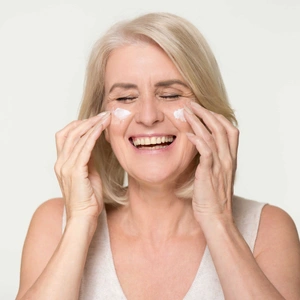
How To Treat Turkey Neck: Here’s What You Need To Know
As we get older, sagging skin on the neck (so-called “turkey neck”) is a common occurrence. Here's what you can do about it.

The Best Anti-Aging Skincare Products For Your 50s
In our 50s, signs of aging are generally already visible on the skin. Here are some of the best ways to take care of your aging skin.

‘Skinimalism’: The Skincare Purge To Know About
Skinimalism focuses on the minimum to meet your skin care needs, prioritizing sun protection, hydration, and cleansing over heavy makeup.

Anti-Aging Skincare In Your 20’s: The Right Time To Start
When you’re young, it seems like your skin can take care of itself, but your 20's are the perfect time to start a good anti-aging routine.

Rachel Sheldon
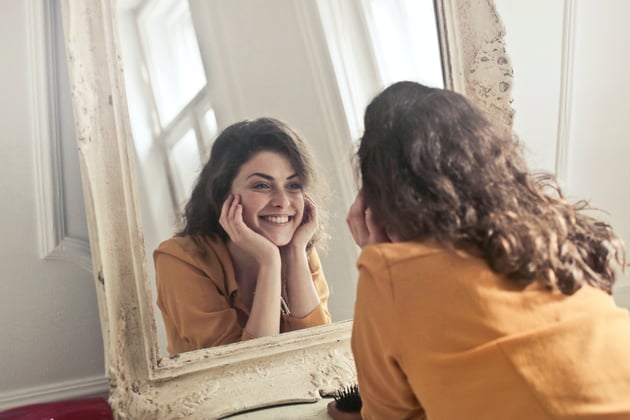
I’ve been suffering from persistent hormonal acne for about 10 years. And like most people with acne, I've temporarily "cured" it for short periods of time only to have it come back with a vengeance. In the last decade, I’ve tried almost everything to fix my skin and get rid of my acne for good. Some things worked, at least for a short time (such as clindamycin and benzoyl peroxide) and others had disastrous results.
Acne can have such a profound impact on a person’s self-image. Personally, my acne defined me for so many years. I saw myself as “that girl with bad skin” and thought that I would always be this way. Having acne destroyed my self-confidence – at times, I didn’t even want to leave the house because I felt so awful about my skin. I refused to go in public without makeup on, and I was terrified of anybody but my closest friends and family seeing my bare face.
After years of struggling, trying every fad diet and fancy serum under the sun, spending thousands upon thousands of dollars along the way, I can finally say that my acne is gone! I haven't gone this long without a breakout since I was in middle school. Over the past 6 months of following this routine, my acne has steadily decreased to the point that I haven’t gotten a cystic zit or anything more serious than a whitehead for nearly 2 months now.
It took me a decade to finally figure out what works for my hormones and my skin, and my biggest takeaway is this: find a dermatologist you trust . I resisted seeing a dermatologist for years because of negative past experiences, but once I finally put in the effort and found someone who really listens to me and cares about how I feel, it was a game-changer.
Without further ado, here’s what I’ve been doing for the past 6 months to heal my hormonal acne. Hopefully this helps you and gives you some confidence that it is possible to heal acne, it just takes a lot of time, patience, and a great dermatologist!
Part I: Tretinoin
The first big change I made that had a huge impact on curing my acne was tretinoin. Otherwise known as Retin-A, tretinoin is a vitamin A derivative that’s been proven over many years of research to help cure acne (as a bonus, it also has major anti-aging powers – win-win!) I wrote up a blog post all about the different types of retinoids available, which you can check out here .
I did a ton of research on tretinoin before taking the plunge and getting a prescription from my dermatologist, so I felt quite confident starting it. I started off with the tretinoin cream formulation at 0.025% concentration. This is the lowest and least irritating formulation you can get. After about 5 ½ months using 0.025%, my results had plateaued and I decided to go up to the 0.05% concentration, which is what I’m using right now.
In the beginning of using tret, I applied every third night. Then after a couple weeks, I moved up to every other night. Then, after I felt my skin could tolerate it, I moved up to using it every night, which is what I’ve been doing for the past 3 ½ months.
I experienced some dryness and peeling around my mouth at the beginning, but it was solved by applying a barrier (like Vaseline) before tret. I also incorporated the La Roche Posay Cicaplast Baume B5 on my dry areas, which did an amazing job of moisturizing and soothing my skin.
Part II: Spironolactone
The other major change that I attribute my success in healing my hormonal acne to is spironolactone. Spironolactone is a medication that inhibits androgens which tend to cause acne. DISCLAIMER: Spironolactone is a prescription medication and should only be taken under a doctor’s supervision.
I saw my general physician and asked to go on spironolactone after doing some research and hearing about its amazing results for hormonal acne. Spiro is often prescribed along with birth control, since you are not supposed to get pregnant while taking spiro. I had already been on a birth control pill specifically meant for acne for several years, so that is the combination I’m taking right now.
I started off with 50mg daily of spiro, which is a low dose. After about 3 months seeing little results, I bumped up to 75mg daily which definitely improved my breakouts. So far, I haven’t had any serious side effects, but it is possible to experience dizziness, light-headedness, nausea, headaches, and other effects so be aware and make sure to speak to your doctor about this. Spiro is also a diuretic so you need to make sure to stay extra hydrated (be warned that you will have to pee – a LOT).
Part III: Azelaic Acid
Finally, I incorporated azelaic acid into my routine about 2 months ago, which has really helped reduce redness. I’m very prone to redness and PIH, and I have rosacea which is what azelaic acid is commonly prescribed for. I’ve been using Paula’s Choice 10% azelaic acid every other day, and I’ve been loving it so far. In the future, I will likely get a prescription from my dermatologist for a higher concentration of azelaic acid (also called Finacea).
My AM Routine
- Cleanse with CeraVe Hydrating Cleanser or Neutrogena Ultra Gentle Hydrating Cleanser
- Paula’s Choice 10% Azelaic Acid Booster OR The Ordinary Niacinamide + Zinc Serum
- Moisturize with CeraVe Moisturizing Cream (in the tub)
- Sunscreen (NEVER skip sunscreen while on tretinoin, even when you’re staying inside all day! My current favorite is Paula’s Choice Super Light Daily Wrinkle Defense SPF30 but I also like the ones from EltaMD)
My PM Routine
- Remove makeup/sunscreen with an oil or balm cleanser (my favorite is the Boscia MakeUp BreakUp Cleansing Oil , but right now I’m trying out the Drunk Elephant Slaai Makeup Melting Butter Cleanser )
- Moisturize with Neutrogena Hydro Boost Water Gel (the fragrance free version only!) OR CeraVe in the tub (depending on how dry or irritated my skin is feeling)
- Wait 10-20 minutes to fully dry (Never apply tretinoin to damp or wet skin!)
- Apply pea-sized amount of tretinoin all over my face, avoiding the mouth and eyes (I like to apply a generous amount of CeraVe Healing Ointment to my lips before tretinoin, otherwise the corners of my mouth start peeling)
- Optional: Apply La Roche Posay Cicaplast Baume B5 to dry areas
- Optional: Pimple patch on any active zits
Before and After Pictures
*I only bothered showing the bottom half of my face in these pictures since that's where 100% of my acne was, since it was all hormonal.
Before starting tretinoin (March 2020)
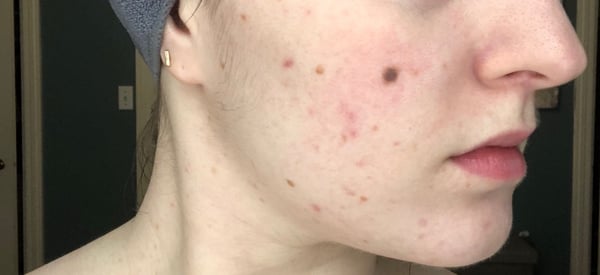
2 months into tretinoin 0.025% while purging (May 2020)
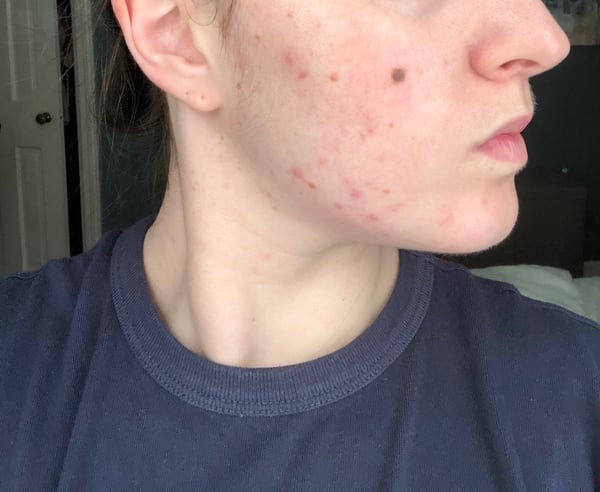
6 months into using tretinoin 0.025% (September 2020)
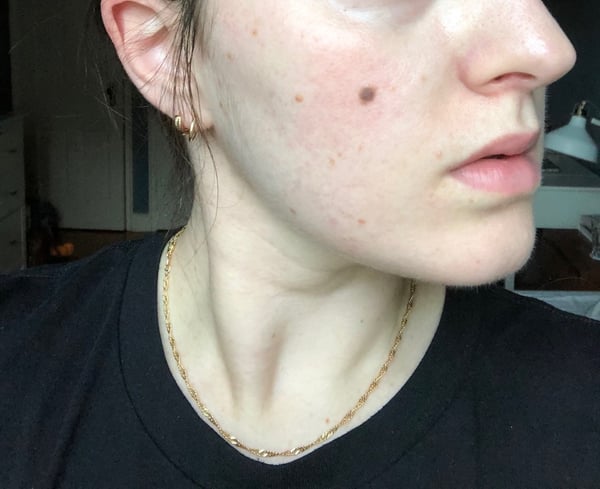
There's such a huge difference in not only my acne, but the texture and tone of my skin from the first pictures until now. I even have a little bit of that sought-after "tret glow" in the last photos! As you can see, I still do suffer from some leftover PIH and redness, and I get occasional small pimples which I'm hoping the tretinoin 0.05% will help get rid of. Overall, I'm extremely happy with my progress and I've never felt better about my skin!
Leave a Comment

Hi, I'm Rachel! Welcome to my blog.
Related Articles.
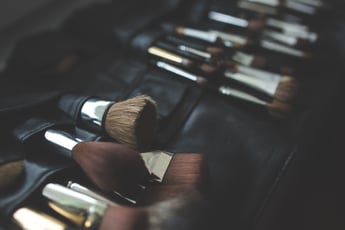
My Holy Grail Makeup Products
As I've mentioned before, I'm a skincare junkie. But even before I was a skincare junkie, I was a...

My Top 5 K-Beauty Products
I may be a little late in the game, but I've recently become obsessed with Korean beauty (or...
Select a treatment to get started

Trying Tretinoin Week 1: Complete Step-by-Step Skin Routine For Starting Tretinoin
Trying Tretinoin: a tretinoin field guide. Follow along while I document week-by-week the start of my Tretinoin journey.
So, you’ve heard of tretinoin (aka the brand name, Retin-A) and you’ve seen the stellar before and after pictures.
But you’ve also heard of some scary tretinoin caveats.
Listen, I was right where you are now. Wondering if this product could finally take care of my acne, but scared of the process.
This is why I'm writing a tretinoin field guide. I’m trying tretinoin as an acne treatment and reporting my experiences, tips, and tricks.
If you're wondering how to start tretinoin like a pro, this field guide is for you.

Why I’m starting tretinoin
Tretinoin has been called the foundation of effective acne therapy and is a mainstay in anti-aging skincare. I want to try tretinoin to clear up adult acne and brighten old acne marks.
All my life, I had crystal clear skin. That was until I was about 23. (I skipped middle school acne and jumped headfirst into adult acne.)
Throughout the years I’ve worked to stabilize my hormones and step up my skincare. But, my skin continues to be temperamental.

Since tretinoin increases skin cell turnover, it can push clogged pores to the surface, and keep pores from getting clogged in the first place. In other words, it’s pretty great for acne.
It can kill acne-causing bacteria, reduce inflammation, and regulate sebum production.
Over time, it resurfaces your skin -- ridding old acne hyperpigmentation and scarring. Eventually resulting in clear, healthy-looking skin.
But there’s a bit of a caveat to this treatment, as it can initially cause peeling, irritation, sun sensitivity, and cause skin purging. When you start tretinoin you’ve got to know your stuff, and have a plan.
My game plan for avoiding tretinoin irritation
While the good side to tretinoin is pretty amazing, the side effects can scare people away from using it. (Including me.)
If you have acne, you are already fighting tooth and nail to keep your skin clear -- the idea of voluntarily causing a “purge breakout” feels insane .
But, the purge is very temporary (for most) and is actually a good sign the product is doing its job.
Sadly, there isn’t too much you can do about skin purging. You can, however, reduce irritation by prepping your skin and allowing for acclimation.
Here is what I did when I started tretinoin:
1. Prep the skin
I prepped my skin by focusing solely on increasing the health of my skin barrier. I used hyaluronic acid, ceramide-rich products, peptides, and I used very mild cleansers.
If you prepare your skin well, you won’t be putting a powerful retinoid onto dry, over-exfoliated, or undernourished skin. You’ll be putting it on skin that’s protected and ready to take the hit of a retinoid.
I stopped using products that are harsh and stripping like alcohol-based products, AHA/BHA treatments, and harsh foaming cleansers in preparation a few weeks before starting.
2. Formulations and compound products
Second, I considered formulations. You can buy tretinoin-only products and they’re great. But, studies show that using compound tretinoin products that contain niacinamide can decrease redness, itching, irritation, and peeling.
Niacinamide is skin-loving, calming B-vitamin that acts as a buffer between your delicate skin and the powerful retinol.
My prescription from Strut Health combines 0.05% tretinoin, prescription-strength niacinamide and a small amount of lactic acid.
3. Tretinoin concentration
It’s important not to jump the gun with tretinoin strengths. I made sure to start with a medium-dose product. My formula is 0.05%.
It’s recommended to start with a low dose and build up your tolerance.
In general, 0.05% is well tolerated as a starting point for most skin types.
Studies have shown that 0.05% produced more skin improvement when compared to the weaker 0.01%.
4. Frequency schedule to ease in
A golden rule when it comes to tretinoin is, slow and steady wins the race.
Your skin needs time to acclimate to this powerful product. Jumping in the deep end can cause uncomfortable irritation.
This is why it’s recommended to ease in. A good rule of thumb is to take a month to allow your skin to acclimate before using regularly. A schedule of acclimation might look like this:
Week 1: Use once a week
Week 2: Use twice a week with two days in between.
Week 3: Use three times a week with one day in between
Week 4: Use four times a week with one day in between.
*If irritation occurs, slow down! You can cut your tretinoin with moisturizer if it’s too strong for you, or step back to a less frequent schedule for a few weeks.
By the end of this first month, your skin will likely have acclimated and you can continue on an every other day schedule, but listen to your skin and don’t push it. After the 4th week, you’ll begin to see stubble changes in your skin.
My skin routine for starting tretinoin
When using tretinoin, it’s best to prioritize mild skincare. This means laying off other products that are stripping and exfoliating. Instead, focus on keeping your skin hydrated, and protected.
My morning routine is a little more elaborate than my night routine. Keep scrolling to see the products I am using as I start tretinoin.
All products are acne-friendly, non-comedogenic, and fragrance-free.
Skin barrier replenishing AM routine while using tretinoin:
Step 1: Gentle foaming cleanser
Step 2: Humectant toner while the face is wet (hyaluronic acid)
Step 3: The Buffet (peptides) by The Ordinary plus Niacinamide by The Ordinary
Step 4: Pat on an emollient oil like jojoba oil or rosehip oil if dry or simple daily lotion
Step 5: Tinted SPF 50 and I reapply throughout the day.

Less is more PM routine:
Step 1: Hydrating cream cleanser
*wait for your skin to completely dry*
Step 2: Strut Anti-Aging Formula
*wait for the product to dry*
Step 3: Simple ceramide rich lotion or heavy cream
Step 4: If needed, apply the Cicaplast Baume B5 repairing balm

How I use tretinoin
I wash my face with a hydrating cream cleanser and pat my face dry. As I’m just starting tretinoin, I let my skin completely dry before using tretinoin.
When your face is wet or damp, products absorb more into the skin. And too much too fast can irritate the skin.
So, to avoid that, I normally let my face dry for about 10-20 minutes.
I don’t put anything else on my face before tretinoin. (I skip the normal toner and any other active ingredients.)
Then I pump out a pea-size amount of Strut Anti-Aging formula and smooth it across my face.
I avoid my under eyes, corners of the mouth, and the very sides of my nose as these areas are sensitive and prone to peeling.

Then, I use a simple cream moisturizer that is rich in ceramides and peptides.
In the morning I wash it off and make sure to pack on the SPF.
Tretinoin so far: week 1 acclimation
After seeing how gentle the Strut Anti-Aging 0.05% tretinoin formula is for me -- I used it twice for my first week. I spaced this out with 3 days in between.
(If you have sensitive skin, don’t be as brave. My skin is not sensitive.)
After two uses, I only saw a tiny bit of flaking skin around my nose and acne marks.
Irritation level: 0/10
Acne report: To my surprise, my acne looked somewhat soothed after using it twice. Don’t get me wrong, it was still there (no magic here, folks) but it wasn’t as inflamed as before.
Thankfully, the first week of acclimation went well! Strut Health’s compound formula is thoughtful, packed with soothing niacinamide, and very gentle.
I’ll be stepping it up next week.
Trying tretinoin series
I’m trying tretinoin and reporting a field guide of my results. So many people are nervous to try tretinoin because of the tricky acclimation process and the potential for skin purging.
That’s why I’m here, an acne-prone twenty-something, writing all about what to expect when trying tretinoin.
Follow along to learn how to try tretinoin like a pro.
Week 2 Trying Tretinoin Series
Week 3 Trying Tretinoin Series
Week 4 Trying Tretinoin Series
Week 5 Trying Tretinoin Series
Week 6 Trying Tretinoin Series
Week 7 Trying Tretinoin Series
Week 8 Trying Tretinoin Series
Try tretinoin for yourself
Complete a questionnaire-based online doctor's consultation to see if Strut Health’s tretinoin formulas are right for you.
If our doctors find this is a good fit for you, we’ll ship your prescription to your doorstep.

Related posts
Pimples after shaving your face: why this can happen and how to avoid shave acne, 6 things you need to know about niacinamide cream, how to use a rosacea diary to identify your rosacea triggers in 5 steps, clindamycin and tretinoin acne formulas: do these ingredients work better together, bald spot in beard: is it patchy growth or balding, how to apply tretinoin the right way & avoid angry peeling skin.

The Skin Care Culture
How To Take Better Care of Your Skin
The Complete Beginners Guide to Tretinoin
Are you considering using tretinoin to improve your skin? If so, you may be feeling a little overwhelmed.
This guide is created to help beginners understand everything they need to know before starting their tretinoin journey.
Below, I will explain what tretinoin is and how it works.
I will also give some tips on how to avoid irritation and ease discomfort while using tretinoin.
Lastly, I will help you create the best skincare routine to support your skin and help you get the best results from tretinoin.
So, continue reading for the best tretinoin beginner routine to help you avoid side effects while achieving the clear, healthy, glowing skin of your dreams.
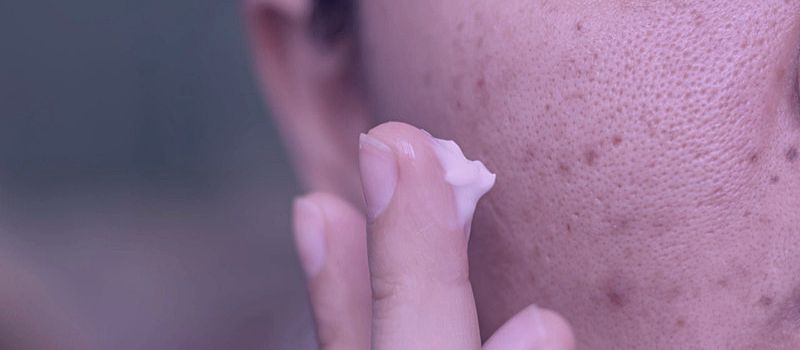
What is Tretinoin?
Tretinoin, or retinoic acid, is a vitamin A derivative used topically for treating various skin concerns .
Tretinoin, all-trans-retinoic acid (ATRA), is a prescription form of vitamin A patented in 1957, FDA approved for medicinal use in 1962, and topical use in 1971.
It was originally marketed under the brand name Retin-A, but there are many brands that you can find today, depending on your location.
All tretinoin products are the same and contain similar ingredients.
What’s different is the brand that carries them and some slight variations in base ingredients, such as polymers that create a slightly different consistency but don’t affect the product’s performance.
Tretinoin comes in either gel or cream formula.
The gel formula usually contains alcohol denat. and is prescribed to those dealing with acne due to its basic and non-comedogenic formula.
The cream formula, on the other hand, usually contains emollients such as isopropyl myristate that soften the skin, which is why cream-based tretinoin is generally prescribed to those with skin aging concerns.
Additionally, tretinoin has three strengths: 0.25%, 0.5%, and 1% (the strongest.)
There are also micro formulas that are usually recommended for sensitive and reactive skin, but these aren’t very popular, and as a result, they are not sold in many countries in the world.
How Does Tretinoin Work?
Once applied to the skin, the active ingredient in tretinoin travels deeper through the epidermal layers and binds to specific receptors involved in the skin’s cellular regeneration process .
This action changes how the cells regenerate, promoting an increased cell turnover rate, which pushes new, healthy skin cells to the skin’s surface.
As healthy skin cells replace older, damaged cells, tretinoin users will notice visible improvement in the skin’s overall appearance.
The Benefits of Using Tretinoin
Consistent tretinoin use will help improve skin health, clarity, and appearance.
- Fades Hyperpigmentation : Tretinoin helps achieve a more even and uniform complexion by accelerating the shedding of dead skin cells, revealing brighter and even skin from underneath.
- Refines Skin Texture : Tretinoin helps refine uneven skin texture by encouraging the production of healthy skin cells, which leads to smoother and softer skin.
- Improves Acne Scarring : Tretinoin can improve the appearance of pitted acne scars by stimulating collagen production, which will fill in and smooth out the appearance of these types of scars.
- Improves Lines and Wrinkles : Tretinoin boosts collagen production in the skin, which helps improve skin elasticity and firmness, leading to a more youthful appearance and decreased lines and wrinkles.
The Side Effects of Using Tretinoin
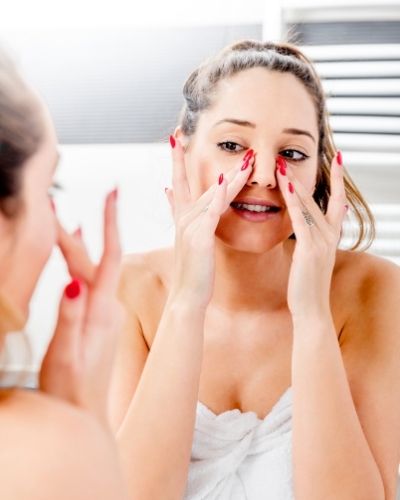
While tretinoin can improve many skin concerns, it’s also notorious for the initial discomforts it causes for many during the acclimation period.
Here are the main side effects of using tretinoin:
- Dryness : Dryness occurs because younger cells pushed to the skin’s surface have a decreased moisture-retaining capacity, leading to moisture evaporation and dry skin.
- Irritation : Increased cellular turnover and dryness can lead to irritation, which is another temporary side effect directly caused by tretinoin.
- Flaking : The increased number of dead skin cells on the skin’s surface will appear dry and flaky initially until the skin acclimates to the active ingredient in tretinoin.
- Peeling : Tretinoin causes peeling because it accelerates the skin cell turnover process, leading to the shedding of old, dead skin cells on the surface.
- Purging : Another common side effect of tretinoin use is purging, which is when your skin breaks out more because the active ingredient causes it to expel the clogs inside the pores towards the skin’s surface faster.
- Sun Sensitivity : Increased sun sensitivity is a common side effect of using tretinoin, which means you must be diligent with your sunscreen application, or your skin will likely burn more easily while on tretinoin.
How to Start Using Tretinoin?
When it’s your first time using tretinoin, you should start by applying a pea-sized amount of the lowest-strength formula to your skin every 72 hours or three days .
It’s essential to be patient and gradually increase the frequency of use to every other day, then daily, over several weeks of use for each increase.
This will help your skin acclimate to the active ingredient and minimize any initial side effects.
Additionally, avoid applying tretinoin to damp skin to reduce potential irritation. The skin is more porous when damp, which means the active ingredient can penetrate deeper, increasing the potential for dryness and irritation.
Finally, when starting tretinoin, make sure your skin is always moisturized and protected with high SPF during the day.
This will help prevent dryness, irritation, and sunburn while your skin adjusts to the active ingredient and the increased cellular turnover it promotes.
Remember, patience is key when using tretinoin, as results can take several months to become noticeable.
But with consistent use and following these tretinoin tips for beginners, you’ll be on your way to healthier, more radiant skin.
How to Apply Tretinoin Correctly?
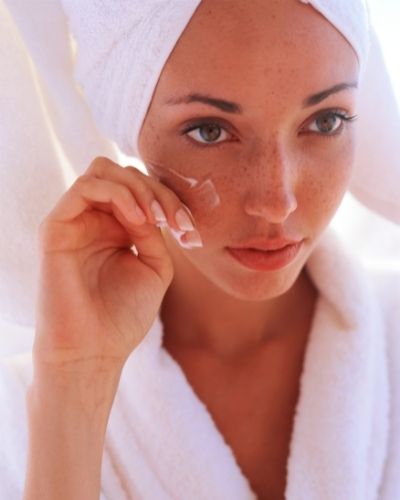
The first step of your tretinoin routine should be cleansing with a gentle facial cleanser that won’t strip your skin or cause further irritation.
After cleansing, wait until your skin is fully dry, and apply a pea-sized amount by dotting bit by bit in different areas of the face, including the forehead, cheeks, chin, temples, and jawline.
Once your dots are evenly distributed, rub the product into the skin with only two fingertips. You don’t want your tretinoin to stay on your hands, so it’s important not to rub it in with all your palms or more than two fingers.
After you’re done, wash your hands with soap because your fingertips will start to peel if even a little bit of tretinoin remains on them.
Wait at least 30 minutes before following up with a moisturizer, as this will give tretinoin time to settle and absorb into the skin without being moved around, which could lead to uneven coverage.
When to Expect Results from Using Tretinoin?
Skin improvements from tretinoin use will be visible after 3-6 months for acne, six months to a year for hyperpigmentation, and 1-2 years of consistent use for lines and wrinkles .
It’s also important to note that any skin improvements require continual use for maintenance, as your skin can revert to its previous state if you discontinue the use of tretinoin.
This is because tretinoin promotes and maintains a healthy skin cell turnover cycle.
If you stop using it, your skin will eventually return to its regular cell turnover rate, which may be slower and cause issues such as acne, hyperpigmentation, texture, lines, and wrinkles.
Assuming the treatment is well tolerated, the only reason to discontinue the use of tretinoin would be pregnancy due to the potential effects it may have on fetal development.
5 Tips for Keeping Your Skin Healthy While Using Tretinoin
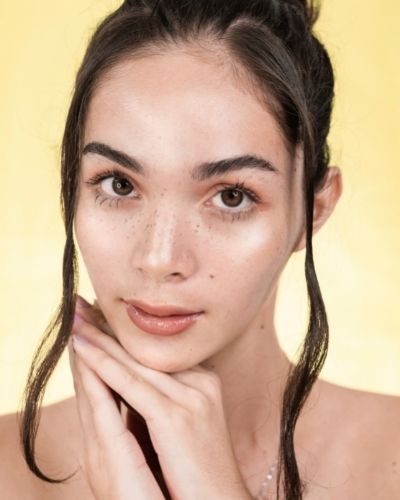
Here are five tips on how to keep your skin healthy when starting tretinoin:
Apply Tretinoin to Dry Skin
Tretinoin is more readily absorbed by wet or damp skin, making it more aggressive and likely to cause irritation, stinging, and sensitivity.
This is why you should always apply tretinoin on clean, dry skin.
Apply Tretinoin on Alternate Days
Start by applying tretinoin every 72 hours because this may help your skin get used to it faster.
Tretinoin triggers a reaction known as “retinization,” which is the binding process that initiates a series of biochemical reactions that regulate gene expression, which in turn influences cellular processes like cell growth and differentiation.
Retinization is also the process of your skin getting used to the active ingredient and showing the common initial side effects associated with tretinoin use.
This process slows down after around 72 hours of the last tretinoin application.
Therefore, using tretinoin every 72 hours, especially when starting treatment, can help avoid a retinization loop – the state of allowing retinization to slow down and get kickstarted again with the next tretinoin application.
This will cause you to constantly deal with the side effects, while your skin will take longer to get used to the active ingredient.
So, while you think you are helping your skin by only applying tretinoin two times a week in the beginning, you may be actually prolonging the process of getting used to the active ingredient.
However, with all this said, you should always listen to your skin, and if you are experiencing uncomfortable symptoms such as intense stinging or burning, you should definitely slow down tretinoin use.
On the other hand, if starting with tretinoin application every 72 hours seems to work without upsetting your skin too much, you should keep up the tempo.
Apply Tretinoin Twenty Minutes After a Moisturizer
When starting tretinoin, you want to take your moisturizing game seriously and diligently apply moisturizer in the morning and evening (20-30 minutes after applying tretinoin), as this will help soothe and protect your skin barrier .
A damaged skin barrier can not only feel uncomfortable and show signs of dryness, redness, irritation, stinging, and burning but can also lead to long-term conditions such as dermatitis and rosacea, which will prevent you from using tretinoin.
Therefore, while you may rely on tretinoin for any other skin concern, keeping your skin barrier healthy should be the top priority when starting this treatment.
Apply Moisturizer over Tretinoin
If your skin becomes too irritated , it’s best to avoid applying tretinoin for several days.
Alternatively, you can apply tretinoin 20-30 minutes after moisturizing.
This method will buffer the strength while still giving the desired results.
Have a Gentle Skincare Routine When Starting Tretinoin
A simple skincare routine that consists of gentle products is key when starting tretinoin, as your skin will likely get irritated in the first few weeks and need special care and support.
The Best Skincare Routine When Starting Tretinoin
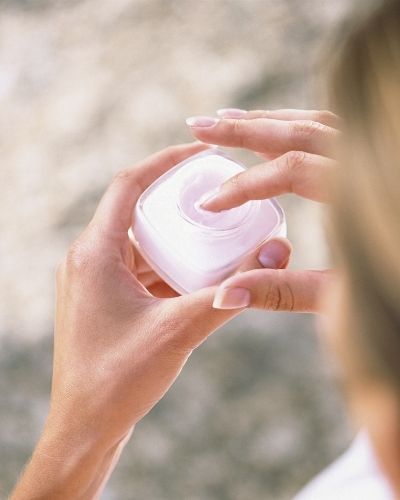
Here’s the best skincare routine for when starting tretinoin:
Gentle Cleanser
A gentle, non-foaming cleanser that won’t strip and dry out your skin is important when starting your tretinoin journey.
RELATED: Best Cleansers While on Tretinoin .

Nourishing Serum
A nourishing serum isn’t a must, but it can be a beneficial addition to your skincare regimen when starting tretinoin, as it can help hydrate the skin and ease some of the initial discomfort.
Opt for products containing hydrating, soothing, and nourishing ingredients, such as hyaluronic acid, green tea, licorice extract, chamomile, etc.
RELATED: Medik8 Hydr8 B5 Intense Moisturizing Serum Review .
Heavy-Duty Moisturizer
As mentioned above, moisturizing is one of the most important steps in your tretinoin journey.
A good moisturizer will support your skin barrier and reduce irritation.
RELATED: Best Moisturizers While on Tretinoin.
Pick a sunscreen with a high SPF of 30 and higher that’s gentle and non-irritating to your skin.
RELATED: Best Sunscreens While on Tretinoin.
What You Shouldn’t Use While on Tretinoin?
Here are some skincare ingredients you should stay away from while using tretinoin:
- Exfoliating acids (AHAs, BHAs, and PHAs.)
- Exfoliating enzymes (pineapple, papaya, and pumpkin.)
- Scrubs (granules, powders, and kernels.)
- Alcohol denat.
- Essential oils.
These can make your skin more irritated and uncomfortable, compromising its barrier, prolonging healing, and potentially leading to long-term inflammatory skin conditions.
RELATED: Can You Mix Benzoyl Peroxide With Tretinoin?
Extra Tips for Starting Tretinoin
Besides being armed with the knowledge of how tretinoin works, what are some benefits and side effects of using it, and how to use it correctly and minimize discomfort, here are a few extra tips for starting tretinoin that can help you get through the initial phase more smoothly:
Don’t Rush Into Increasing Usage
When starting tretinoin, it’s crucial not to rush into increasing its usage.
Your skin needs time to acclimate to the potent active ingredient because retinoic acid will create many changes in cellular function, which will take time to adjust.
If you increase the frequency too quickly, it can lead to excessive dryness, peeling, or even severe irritation.
These side effects can be uncomfortable and might discourage you from continuing with the treatment.
They can also lead to more severe and even permanent skin conditions, such as dermatitis and rosacea.
Therefore, slowly and steadily increasing the usage allows your skin to build tolerance gradually, leading to better results and fewer side effects in the long run.
Remember, maintaining healthy skin is a marathon, not a sprint.
Stick to Low-Strength Formulas
While you may be tempted to dive into higher-strength tretinoin formulas in hopes of seeing faster results, as a beginner, it’s wiser to stick to low-strength options.
High-strength formulas can bombard your skin with too much retinoic acid at once, leading to inflammation, excessive dryness, and other reactions that can disrupt your skin’s barrier function.
On the other hand, low-strength formulas deliver the benefits of tretinoin, such as accelerated cell turnover and collagen production, but at a gentle pace that is more manageable for your skin.
This allows your skin to acclimate to the active ingredient and reduces the risk of severe, uncomfortable side effects.
Remember, patience and consistency are key to maintaining healthy skin.
Don’t Apply Too Much Product
Less is definitely more when starting tretinoin.
Applying more product than necessary won’t speed up your results, but it could cause irritation, redness, and peeling that could’ve been avoided with correct tretinoin use.
Retinoic acid is a potent active ingredient; a pea-sized amount is all you need to cover your face without exacerbating discomfort.
Learn How to Relieve Side Effects
Mild side effects such as dryness and irritation when starting tretinoin are common, and learning to relieve them is crucial, particularly for beginners.
As you embark on your tretinoin journey, your skin may encounter changes that could be uncomfortable.
Adopting a gentle skincare regimen can help alleviate these effects, ensuring your skin remains healthy and can heal faster.
Listen to Your Skin
Listening to your skin is definitely one of the most critical aspects of your tretinoin journey, as is managing potential side effects.
Your skin is your body’s largest organ, and it communicates with you in its unique ways.
Just like you wouldn’t ignore a headache from not drinking enough water, you shouldn’t overlook severe discomfort or any abnormal reactions from using tretinoin, as these signal that your skin needs a break from the product.
Rather than persisting with continuous application despite these signs, taking intermittent breaks allows your skin to recuperate and adjust to the active ingredient.
This enhances your tretinoin usage experience, reduces potential skin damage, and makes the journey smoother and more beneficial in the long run.
Learning to discern these signals and responding accordingly is vital for beginners embarking on their tretinoin journey.
Frequently Asked Questions
Here are some frequently asked questions by tretinoin beginners:
Which Tretinoin is Best for Beginners?
0.025% is typically the lowest strength widely available on the market and the most suitable option for tretinoin beginners.
There are also lower or micro formulas of 0.01%-0.02%, which are best for sensitive and reactive skin; however, they aren’t that popular and widely available, so you may be unable to find them in your country.
When to Start Tretinoin?
Tretinoin is deemed safe for children as young as 12 years old and is often prescribed to teenagers who are experiencing puberty acne.
However, the best time to start tretinoin is in your early 20s.
Can You Use Tretinoin Every Night?
Yes, tretinoin can be used every night, provided your skin tolerates it well.
However, starting with application every third night is recommended to allow your skin to adjust to the potent active ingredient.
My Other Tretinoin Related Articles:
Is Generic Tretinoin as Effective as Retin-A?
Does Tretinoin Work for Wrinkles?
Adapalene vs Tretinoin: Which is the Best for Anti-Aging?
How to Layer Tretinoin With Other Products?
10 Best Moisturizers to Use With Tretinoin
How to Fix Dry Skin From Tretinoin?
How do You Know Tretinoin is Working?
Can You Mix Benzoyl Peroxide With Tretinoin?

My name is Simone and I am a certified skin specialist. I created this website to teach my readers how to take great care of their skin and I also like to occasionally share my honest opinions on skincare products I’ve tried. You can learn more about me here .
The Acne Solution : Your Ultimate Guide To Flawless Complexion

An extensive, no-nonsense course showing you how to never have acne again , from a licensed Esthetician specializing in oily/acne-prone skin .
Leave a Comment Cancel reply
Save my name, email, and website in this browser for the next time I comment.
- FIND A PROVIDER
I'm a Candidate
I'm a Provider
Log In / Sign Up
I'm a candidate
Provider login
I'm a provider
List your practice
I Finally Tried Tretinoin And I’m Never Going Back
Download the app
The AEDITION
- Patient Perspective
As a beauty editor, being non-committal to skincare products and tools is a part of the job. While there are lotions, potions, products, ingredients, and devices we know are tried and true, it’s also our duty to test out the latest launches to stay abreast of the innovations on the market. Consider it research. Therefore, by keeping my vanity open to new products, maintaining a curated routine has been a challenge. Yes, I am mindful of the ingredients I use and how they play together, but, I am not as selective on which cleanser or moisturizer I will use from week to week. So, it comes as no surprise that most of my twenties were spent experimenting and prioritizing product testing over tailoring a personal routine – until I hit 30 .
Knowing that my skin wont be smooth forever as fine lines, dullness, and pigmentation are a part of life, I knew it was time to do what I’ve been dreading: sticking to a routine with tretinoin. Because adding a prescription-strength vitamin A into the regimen requires a methodic approach (and patience), my hesitancy prevented me from diving into the deep end. Three months ago, I decided to finally incorporate the holy grail of youth-preserving ingredients into my routine, and here’s how that journey went.
What is Tretinoin?
For the newbies, tretinoin is “ a vitamin A derivative, a type of retinoid that is available as a prescription,” explains Marisa Garshick, MD , a board certified dermatologist based in New York. The workhorse ingredient works by regulating skin cell turnover and can help prevent and treat acne, explains Dr. Garshick. But, the fun doesn’t stop there. “Additionally, because it can also help boost collagen production, it can help to improve the appearance of fine lines and wrinkles, in addition to acne scarring,” she adds. To simply put it, the prescription-strength ingredient “can help to improve overall skin tone and texture.”
The ingredient requires a prescription, and while Dr. Garshick was not my personal dermatologist, her insight is invaluable when it comes to all things skincare.
How To Add Tretinoin To Your Skincare Routine
What kept me from starting sooner was the barrier to entry, it is a process that requires more than a prescription to truly make it work. Below are some of Dr. Garshick's tips and recommendations for starting tretinoin.
- Start Slow : When adding any new product into your routine, especially one as potent as tretinoin, modesty is key. A pea-sized drop of the ivory cream is recommended once a week to build up a tolerance, and with time, the amount can be adjusted. As we always say, let your skin guide you and tell you what it needs. “It is best to incorporate tretinoin into a nighttime routine and, to start off using it just a few times per week and then increase the frequency as tolerated.”
- Limit Exfoliants : Over-exfoliating the skin can cause a weakened skin barrier, loss of moisture, and therefore, more breakouts to arise. “It is best to avoid using any ingredients that can be harsh on the skin at the same time as tretinoin, such as exfoliating acids, including salicylic acid, and benzoyl peroxide – unless directed to do so.”
- Be Patient : From purging to causing irritation, tretinoin is fickle as the barrier of entry is almost like an initiation process. Because the skin’s experiencing increased cell turnover,
- Skip the SPF : Sun protection should not only be the first line of defense in any skincare routine, it is vital when using a chemical exfoliant. “It is important to always be good about sun protection when incorporating a retinoid into your routine and wearing daily sunscreen,” adds Dr. Garshick.
- Worry About A Purge : Purging, as it is lovingly known, is the process of the skin breaking out which may seem paradoxical considering the ingredient's efficacy when treating acne. However, this is perfectly normal and to be expected. If the acne persists, speak with a trusted dermatologist to adjust the routine or switch to a retinol alternative (hello, bakuchiol ).
- Complicate Things : It’s natural to want to rush the process, the benefits are numerous, after all. During the adjustment period, focus on the basics and how your skin adjusts before incorporating additional products. “I recommend applying tretinoin after cleansing and before moisturizing, but for those with dry or sensitive skin, it may be used after applying moisturizer which may help reduce the potential for irritation in some individuals,” Dr. Gashick advises.
My Experience With Tretinoin
We often discuss the timing of starting a product, the importance of doing a patch test, and the mindful approach required to ensure all ingredients work in harmony, so, to do this right, I overhauled my routine. My first step was to start tret during the winter months due to the decreased sun exposure I would have as my skin acclimates. My second step was cutting out other physical exfoliants. Due to tret being a heavy-duty chemical exfoliant, I opted to shelve my favorite AHAs and BHAs for the time being. Because of my hesitancy to stick to a set routine, I wasn’t going to take any risks with over-exfoliating. Here is a breakdown of my AM and PM routines.
- Environ Sebu-Wash Gel Cleanser
- PCA SKIN Hydrating Toner
- The Ordinary Hyaluronic Acid 2% + B5 Hydrating Serum
- Sunday Riley C.E.O. Vitamin C Brightening Serum
- Aforé Beauty Smooth Shade Tint SPF 30
Daily PM Routine
- Alastin Restorative Skin Complex
- Charlotte Tilbury Cry-Recovery Eye Serum
- Isla Beauty Whipped Dream
Tretinoin PM Routine
- Tretinoin Cream, USP 0.025%
Now, to provide clarity on my skin, it’s normal, not prone to acne, and has very little pigmentation. My reasoning for starting tretinoin was to address any fine lines and wrinkles that may arise with time, as my belief has always been that it’s better to prevent than correct.
During the first few weeks of my journey, the irritation was minimal, and though I was prepared for a purge (cue dramatic music), it never came. Rather than a noticeable breakout, my skin went through a few weeks of whiteheads popping up at inopportune times, slight redness here and there, and more dryness than I usually experience during the colder season. Overall, my fear of the unexpected proved to be just that, a fear.
I have to admit that due to my being a regular person, my routine did waiver as I would try a new product on days when I wasn’t using tret. My goal was to be litigious throughout the process so as to not throw any curveballs, but I did experiment sporadically with a new gentle mask or two. I maintained my rule to avoid all other chemical exfoliants and was consistent with my SPF application (and re-application).
After three months, I can confidently say that my skin looks better than I expected. My primary concerns (fine lines forming on my forehead and marionettes) were not as prominent as my skin adjusted to tret.
The Takeaway
After carrying what felt like a dirty little secret of not incorporating vitamin A in my routine for quite some time, I am happy to report that the ingredient is all it’s cracked up to be. Offering a noticeable change to my skin in a matter of months, tretinoin has provided me with clearer skin, a smoother complexion, and fewer breakouts. Though the adjustment period felt like a waiting game, trusting the process proved to be worth it.

More Related Articles
Related procedures.

‘Try on’ aesthetic procedures and instantly visualize possible results with AEDIT and our patented 3D aesthetic simulator.
Tretinoin for Beginners: What to Do and What to Avoid
Planning to start using tretinoin? Here's what to do and what not to do to avoid irritation.
In This Post
Having come a long way in your search for a tested and trusted solution for your skin problem, the discovery of the wonder-working power of tretinoin can be a breath of fresh air. Deciding to try out tretinoin is an excellent choice to improve your skin and self-confidence. It has worked for many, and your case wouldn't be an exception.
However, it doesn't come without any downsides, as starting tretinoin is often accompanied by purging, skin irritation, and other discomforts.
So, before you begin your tretinoin journey, equip yourself with our tips and tricks to get the desired outcome from the treatment. This article will detail how tretinoin works, how best to use it, and what mistakes you need to avoid to see effective results.
What Is Tretinoin and How Does It Work?
Tretinoin is a synthetic Vitamin A derivative, or retinoid, topically applied to treat acne and clear spots, stimulate a better production of collagen, and reduce wrinkles. Due to the strength of all the percentages of tretinoin, it needs to be prescribed by a doctor.
Most commonly, tretinoin, sold as Retin-A, comes in the form of cream. It achieves its feat by seeping into the depth of the epidermis and interacting with the dermis, causing the stimulation of the skin's metabolism.
Tretinoin accelerates skin cell turnover, the rate your skin sheds old skin cells from its surface and produces new and healthy cells. This process removes the material that plugs your pores, healing acne and preventing the formation of new ones. It also interacts with retinoic acid receptors (RARs) inside the skin, preventing inflammation and boosting collagen production, especially collagen type I and type III [ source ].
The effect of these activities on the skin would lead to rapid but short-lived skin purging at the very beginning of its usage, the so-called retinization process, or the process in which your skin is getting adjusted to tretinoin. Nevertheless, in the end, skin purging only means that tretinoin is working and will pass quickly.
Can Everyone Use Tretinoin?
No, tretinoin is not for everyone. It's a no-no for individuals allergic to tretinoin, and you might not even be aware that you have an allergy until you see a doctor. In addition, children shouldn't use this topical medication unless their doctor approves it; also, pregnant women or women who have plans to get pregnant in the forthcoming months.
Finally, if you have overly sensitive skin, your skin might wildly react against it. Still, with the dermatologist's help, you can receive the recommended percentage of tretinoin suitable for your skin.
What to Do When Starting Tretinoin?
Tretinoin, most commonly sold under the name Retin-A , is the most potent retinoid – it's a pure retinoic acid. Unfortunately, this means that it can cause irritation and dryness, among other side effects. So, try following these tips to avoid or minimize the side effects when starting tretinoin:
Speak with a dermatologist:
A dermatologist visit would determine your skin type and sensitivity as well as the percentage of tretinoin your skin can handle. Based on that knowledge and the nature of your skin problem, you'll receive the prescribed percentage of tretinoin your skin needs to nip the underlying skin issues in the bud. The starting strength of tretinoin cream is usually very low, about 0,01%.
Prepare your skin for the tretinoin journey beforehand:
Because your skin hasn't been exposed to tretinoin, starting it out for the first time can be difficult for it to withstand. To avoid wild reactions and steady your skin for this new phase, you can include a retinoid (like retinol or retinaldehyde) with a lower percentage in your daily skincare routine for about three months. By doing this, your skin is gradually getting adjusted. Once you begin the usage of tretinoin, the past skincare routine would have helped minimize the level of tretinoin irritation on your skin.
Minimize your exposure to sunlight:
One of the expected effects of tretinoin, especially at the outset of its usage, is that it elevates your skin's sensitivity to ultraviolet radiation. Tretinoin's exfoliating properties will leave your skin vulnerable, so you need to protect it. Increased exposure to sunlight can damage skin cells and cause sunburns and irritation. To protect yourself, do well to minimize how much time you spend under the sun, and before you do step out, apply sunscreen with a high SPF above 30.
Things You Shouldn't Do When Starting Tretinoin
The two things you should be aware of when starting your tretinoin routine are combining it with other strong actives as well as the application frequency:
Don't use any exfoliating products:
Including any exfoliating product like scrubs or AHAs, in addition to tretinoin usage, would only lead to over-exfoliation and trigger your skin to be highly irritated. The consequences would show up in the form of burning and itchy skin, redness of the skin, breakouts, and skin peeling.
Don't use it every day:
When it comes to tretinoin treatment, slow and steady wins the race. Aside from the fact that it takes at least six months for this medication to have a deep-rooted fix in your skin cells, the process of its application requires patience. It would help if you used tretinoin as often as recommended by your dermatologist. Nevertheless, once a week is a safe dosage for a beginner.
Tips On How to Use Tretinoin as a Beginner
Follow these additional tips when starting tretinoin to avoid any discomforts associated with tretinoin use:
#1: Use a mild cleanser
As mentioned above, tretinoin can be pretty aggressive on your skin if you're just starting to use it. It can cause drying and peeling. To minimize this effect, make sure to use gentle cleansers without any harsh sulfates, as sulfates will strip your skin of any natural oils. Then follow with a rich moisturizer and tretinoin on top. Once your skin adjusts to tretinoin, you can apply it before the moisturizer.
#2: Apply tretinoin to dry skin
Often, applying tretinoin, as well as other skincare products, on wet skin can boost their effect. So, if tretinoin is applied to wet or damp skin, its potency will be increased, and so will the chance of skin irritation.
#3: Use a pea-sized amount
When it comes to tretinoin usage, less is more. A pea-sized amount is enough to cover your whole face. Apply just a tiny amount on the planes of your face, like your cheeks, chin, and forehead. Then gently spread it all over but avoid applying it close to your mouth and nose as well as around your eyes.
#4: Avoid dabbing tretinoin around sensitive spots
Your lip line, nose, and eyes area are highly irritable whenever they come in contact with tretinoin. So, avoid applying tretinoin to these areas. Instead, it would help if you applied a rich moisturizer or even Vaseline around your eyes, lips, and nose beforehand to prevent tretinoin from seeping into the sensitive areas.
#5: Use only in the evenings
As we already mentioned, tretinoin increases your skin's sun sensitivity. For this reason, use it only as a part of your nighttime skincare routine. Then, wash your face thoroughly the next morning and always follow up with sunscreen with a high SPF.
Takeaway...
Tretinoin as a topical treatment has been a game-changer in the skincare world. However, if you're just starting with the tretinoin routine, remember that the correct application, doing things that will prevent irritation, and avoiding things that can cause irritation, is the key. Plus, consistency and patience are also essential, as it will take some time for tretinoin to work its magic.
So talk to your dermatologist and follow our tretinoin tips for beginners, and healthy and smooth skin will be all yours soon enough.
How do I start tretinoin for the first time?
To start using tretinoin, the most potent retinoid form, you'll have to speak with your dermatologist first to prescribe you an adequate percentage of the product. To avoid irritation, purging, and peeling, you should apply tretinoin only once a week in the evening. And during the day, wear sunscreen with a high SPF.
What happens when you first use tretinoin?
If you've never used tretinoin, or any other kind of retinoid before, your skin will go through the retinization period or the period of adjustment. During this time frame, you may experience skin peeling, dryness, tightness, and purging.
How often should I use tretinoin when I first start?
It would be best to follow your doctor's advice on the frequency of application. However, beginners are usually advised to use tretinoin only once a week for several months. Then, when your skin gets used to it a bit, you can increase it to twice a week, and so on.
What should I know before starting tretinoin?
You should know that tretinoin won't do miracles overnight. It might take six months to a year to see any results. So, taking baby steps and being patient is the key; and the results are surely worth the wait.
Can I apply moisturizer after tretinoin?
Yes, it's even recommended always to use tretinoin with a moisturizer to minimize dryness and peeling. In the beginning, you can even apply the moisturizer first and then your tretinoin cream.
Latest Bits...
How to Make DIY Oils for Hair Growth: Recipes + How to Use
If you're struggling with hair loss and thinning, there's probably no beauty trick you haven't tried already. But did you know that oiling your scalp and hair with DIY oil blends could be the sol...
How to Use Apple Cider Vinegar as a Hair Rinse: A Simple DIY Guide
In the world of beauty, sometimes the simplest ingredients can offer the most remarkable results. Take apple cider vinegar, for instance. This humble kitchen staple has emerged as a star in hair...
How to Make Healing Herbal Baths: DIY Recipes + Benefits
After a long and stressful day, the best way to unwind is to immerse yourself in a warm, soothing herbal bath. These aren't just ordinary soaks; they're a blend of nature's best – an age-old reme...
How to Make DIY Detox Bath Bombs: With and Without Epsom Salt
Looking for ways to de-stress? Indulge in a warm bath infused with a fizzy, fragrant detox bath bomb - the most delightful way to relax and unwind (in our humble opinion, at least). While store-b...
DIY Masks for Oily Hair: 6 Easy Recipes
Oily hair can be a persistent annoyance – you might have to wash it daily, which may worsen the problem. Or you might be forced to use dry shampoo already the next day after hair washing. But bef...

© 2024 All rights reserved.
Exactly How To Add Tretinoin to Your Skincare Routine—Without Overhauling Your Entire Regimen
Your-step-by-step guide to the popular retinoid.
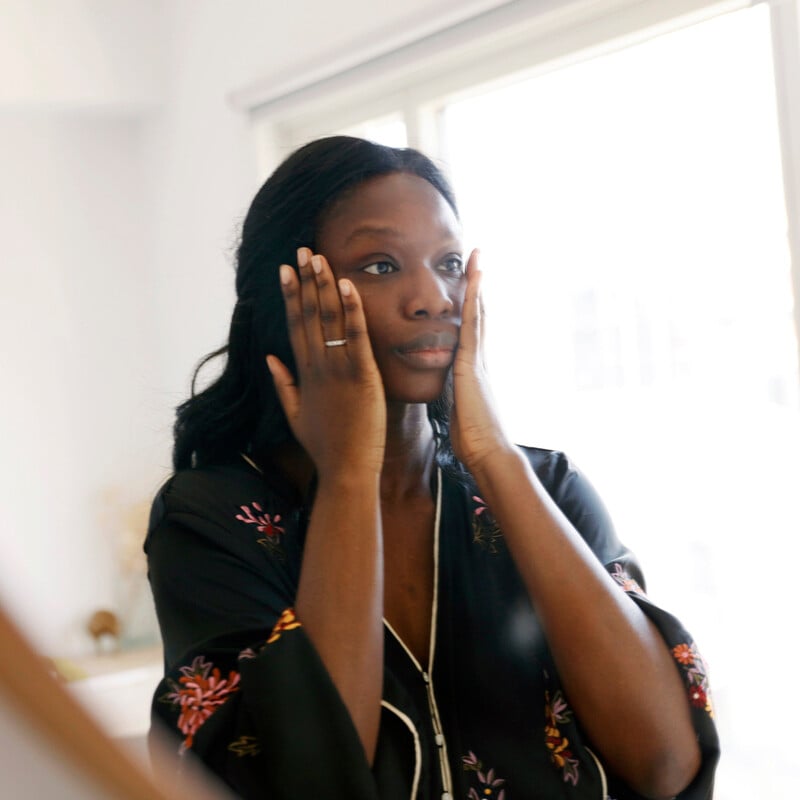
We may receive a portion of sales if you purchase a product through a link in this article.
It takes years to cultivate a skincare routine . And when it comes to taking things to the next level, the best approach is to ask your dermatologist for treatments tailored to your skin. But taking home a prescription is one thing—effectively incorporating it into your skincare habits is another. If you’ve ever put out a Google search wondering “how to use tretinoin,” don’t worry—you’re definitely not alone.
Crafting a skincare routine can be a messy art. Trial, error, trial, (more error), then finally, you have a set of products that work. Until… they don’t. Whether you’re greeted with an unexpected breakout or tempted by a shiny new product, that carefully curated selection on your top shelf is bound to shift.
With new skin concerns come new ingredients that force you to change up your whole regimen . Enter: the tricky dance of learning how to use tretinoin in your skincare routine.
Featured image of Marie Kouadio Amouzame by Belathée Photography .
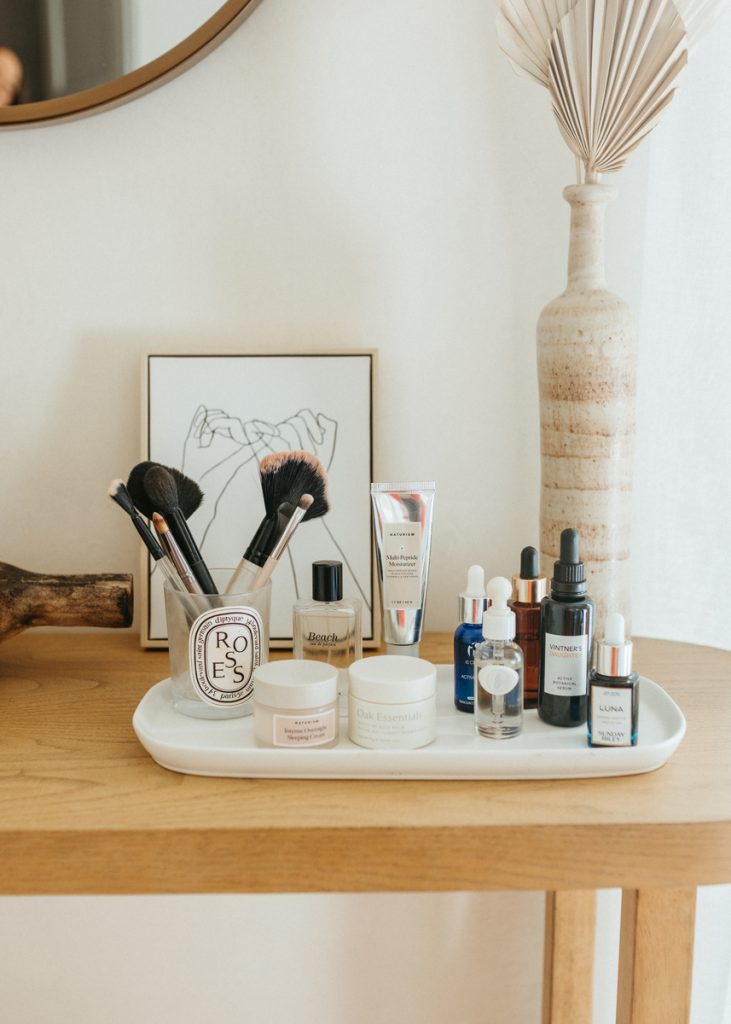
How to Use Tretinoin—and Reap the Glowy Benefits
Tretinoin is the most popular prescription retinoid—and for good reason. It’s effective, comes in different concentrations to tackle different concerns, and is a more targeted treatment than over-the-counter retinol. If you’ve tried your hand at retinol night creams but are still looking to fade hyperpigmentation, fight acne, and reduce signs of aging, tretinoin might just be for you. But to get the most out of it, it’s best to tailor the rest of your routine to prep your skin for your tretinoin journey.
Maybe it’s just me, but I always answer the call of a buzzy new ingredient, a well-packaged aesthetic , and the latest luxury holy grail. My routine has mostly been the same for the past few years, but I make a few exceptions. And to be totally honest, I barter with myself. If I finish one bottle of vitamin C, I let myself buy a replacement from the newest brand I’ve been eyeing on Instagram. Or, when the seasons change, I make an effort to mix things up. Exfoliating masks and collagen body creams in the winter, dewy serums and sunscreen in the spring, and so on.
But it’s not just my temperaments and whims that cause my skincare to shift and sway. Over the years, I’ve learned to listen to my skin. I calm down my routine when it gets overwhelmed, and I step it up when I break out. So, if you’re wondering how to use tretinoin, listening to your skin is paramount to avoid peeling and skin irritation.

What is tretinoin?
Tretinoin is a derivative of vitamin A, aka a retinoid. Tretinoin usually comes in a gel or cream form. Less commonly, it can also be applied topically in its liquid form or even taken orally. It’s one of the most popular ingredients in prescription-strength acne treatments. Like other retinols, tretinoin also helps fade fine lines and hyperpigmentation . Unlike retinols you’re familiar with, tretinoin is much stronger. So much so that it’s only available with a prescription.
Tretinoin cream and gel typically comes in three concentrations: 0.025%, 0.05%, and 0.1%. 0.025% is the mildest and is generally prescribed for overall skin improvement or mild acne. 0.05% is usually prescribed for anti-aging and reducing fine lines and wrinkles. 0.1% is the highest concentration and should be used with caution. Usually prescribed for people who already have experience with retinoids, it’s used for severe cases of acne, melasma, deep wrinkles, and fine lines. Your healthcare professional can help you decide the strength that fits your needs best.
What effect does tretinoin have on the skin?
Tretinoin accelerates cell turnover. But so do over-the-counter retinol creams. So what’s the difference between tretinoin and retinols you can find in your drugstore beauty aisle? Potency. For any vitamin A derivative to work, your skin needs to convert it to retinoic acid. I’ll spare you too much of the science, but tretinoin is stronger because it’s already in the form of retinoic acid. This means your skin doesn’t have to waste time converting it, and it can get right to work.
Because of its strength, tretinoin works faster than OTC retinols. It stimulates cell generation, sloughs away dead skin cells, and sweeps away bacteria from your pores. Additionally, studies show tretinoin helps stimulate collagen production and block acne-causing inflammatory pathways. Combined, this makes it a powerful acne fighter. It has also been FDA-approved for signs of photoaging, like fine lines and dark spots. Overall, it’s a highly effective ingredient for clearer, smoother, more even skin.
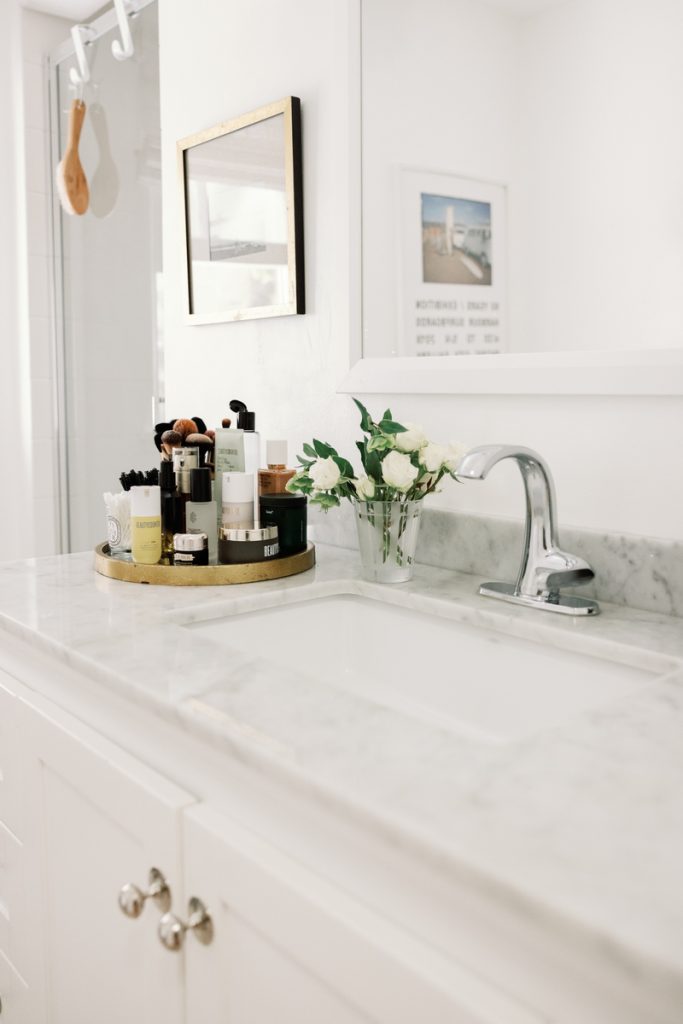
Who is a candidate for tretinoin?
Tretinoin is only available with a doctor’s prescription, so consult a dermatologist if you’re looking to add it to your routine. Your skin type and concerns will determine if tretinoin is right for you. If you’re looking to address fine lines, dark spots, severe acne outbreaks (including cystic acne), and skin texture concerns, tretinoin might be an effective treatment.
To be a good candidate, you also have to have really resilient skin. This means pretty much no sensitivity at all. Most experts recommend starting with an OTC retinol to see how your skin reacts. Tretinoin doesn’t have to be your first choice. Starting with milder retinol might address your concerns. It’s also better suited for people with indented acne scars, severe melasma, or hyperpigmentation. Or, if you’re over 35 and looking to reverse sun damage and signs of aging, tretinoin might be a good option.
As a stronger retinoid, tretinoin is probably not right for anyone who has any degree of sensitive skin. A history of eczema, rosacea, or frequently irritated skin also points to a delicate skin barrier, which tretinoin could compromise further. It’s also probably best to skip using any vitamin A if you’re pregnant, just to be cautious. As in all cases, consult your doctor to find out if tretinoin could be right for you.
Is tretinoin safe to use?
When used properly, tretinoin is perfectly safe. However, due to its potency, users might experience dryness and increased sensitivity to sunlight when they start using tretinoin. To combat this, be sure to up your moisturizing routine and sun protection. It’s also best to start slowly, using tretinoin a few nights a week, then upping your frequency as your skin adjusts. Tretinoin should also not be used excessively or with other actives like acids. This could damage your moisture barrier.

What is the “purge”?
Unfortunately, for many users, the notorious tretinoin purge is real. But it’s not a sign to give up—actually, it’s the opposite! Going through the purge means your skin is adjusting to the treatment and learning how to repair itself.
The first few times you apply tretinoin, your skin is going through more rapid cell turnover than it’s used to. This means all the acne-causing irritants and bacteria are pushed to the surface faster. This leads to inflammation, which causes breakouts. Even if you aren’t using tretinoin to treat breakouts, the resurfacing process might bring latent bacteria to the head, meaning those seeking anti-aging effects might experience the purge, too.
How to Reduce the Purge and Tretinoin Sensitivity
Though there’s not much you can do to stop the purge, resist the temptation to be harsh with your skin. This will only irritate your skin further at such a volatile time. Instead, be as gentle as possible.
Starting slowly with your tretinoin use might reduce the intensity of your purge. If you experience excessive inflammation , you might want to scale down to less frequent use and only use a pea-sized amount. Some ingredients are helpful in soothing the effects of tretinoin, like niacinamide. Niacinamide is a great supplement to your routine because it helps calm irritation while bolstering the effects of your retinoid.
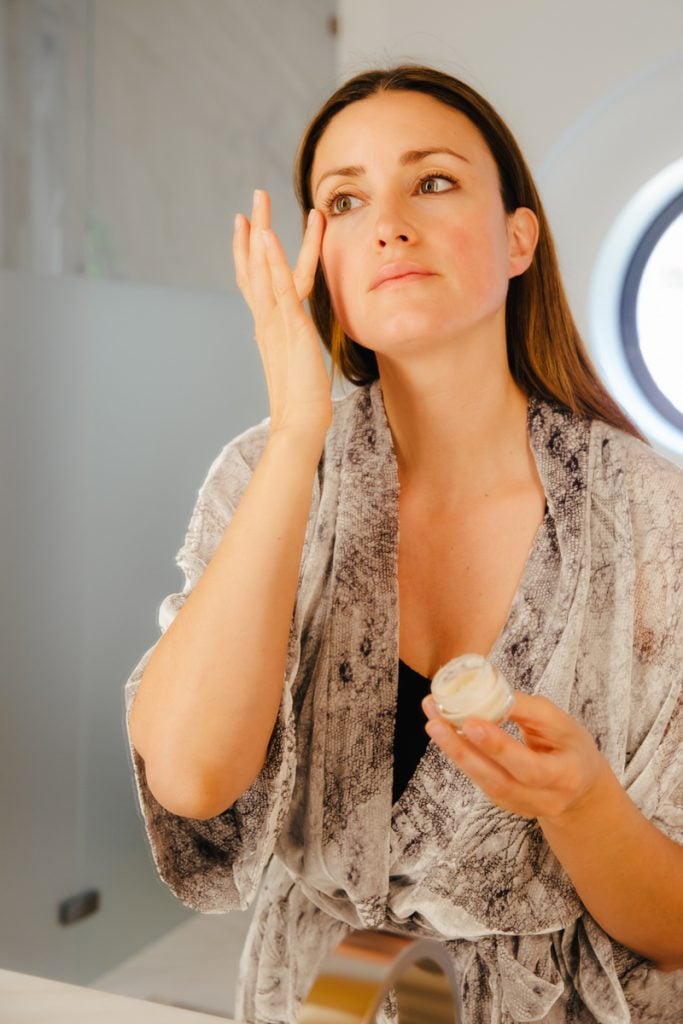
How to Use Tretinoin in Your Skincare Routine
Deciding whether or not to start tretinoin isn’t the only question. How do you implement tretinoin in your skincare routine? How should you use tretinoin for the best results? Many have asked, and the answer is surprisingly simple.
When you start tretinoin, your skin will be going through a lot, very fast. Be kind to your visage and do everything to make the transition as easy as possible. At the outset of your tretinoin journey, focus on ingredients that won’t strip your skin or cause further irritation. You can also add ingredients that work well alongside your prescription retinoid. And, of course, you’ll have to take your suncare even more seriously. Apply the medicine at night, then slather on sunscreen to protect your light-sensitive skin during the day. Eventually, you can reintroduce ingredients like acids back into your routine—but only when your skin is less sensitive.
If this sounds like you have to rebuild your whole routine, I’m not going to lie: you might. Here’s a guide to choosing tretinoin-friendly products to reinvent your skin routine.

The Best Tretinoin Products To Add to Your Skincare Routine
A good cleanser will keep your skin clean without stripping it of natural oils. Be wary of ingredients like sulfates, perfumes, or alcohol in your cleaner. These will dry out your skin at a time when you need moisture the most. Opt for something gentle but effective that doesn’t contain acids. Also, make sure to cleanse gently with your fingertips. Scrubbing with a facial tool or even a washcloth might be too abrasive while on tretinoin.
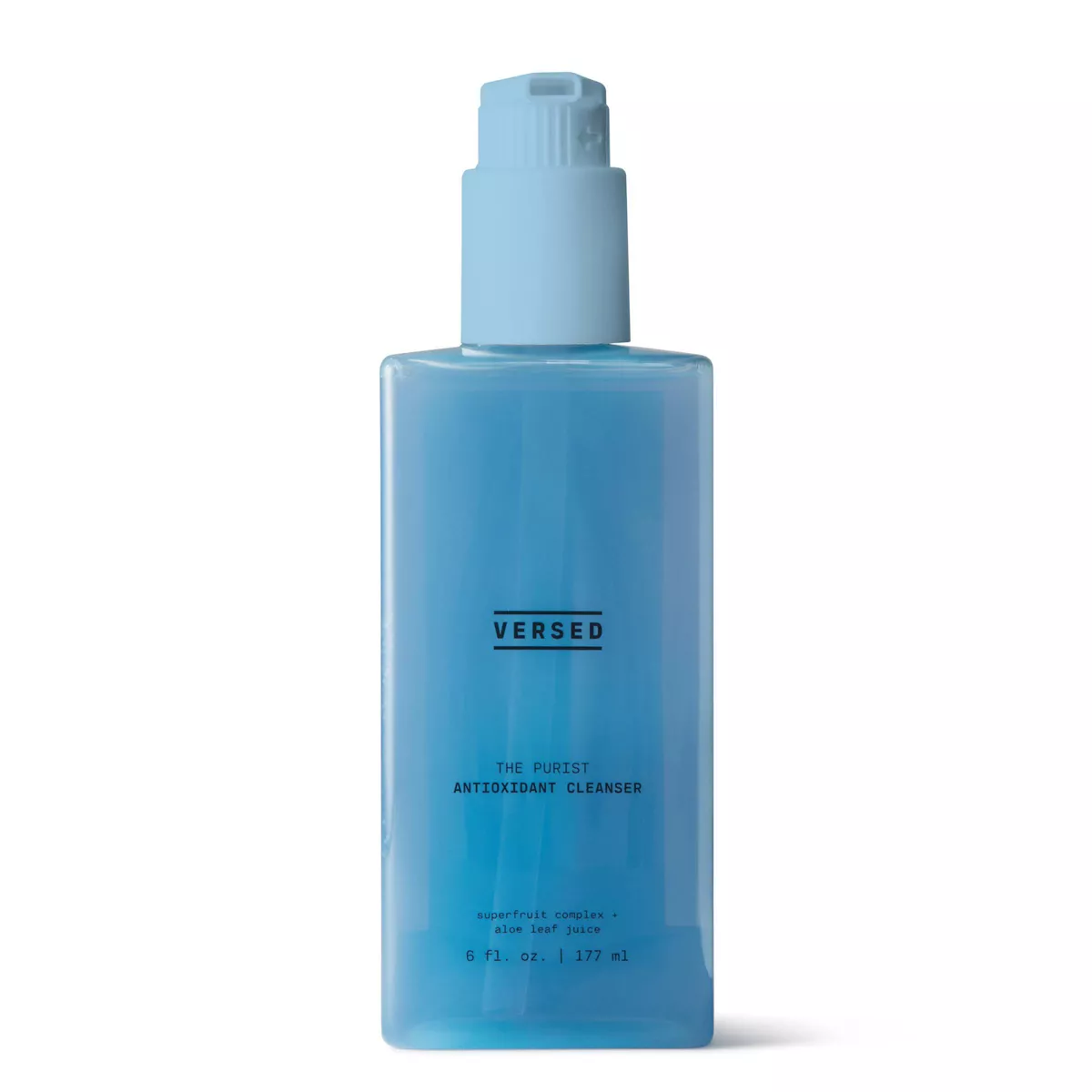
Versed The Purist Antioxidant Face Cleanser
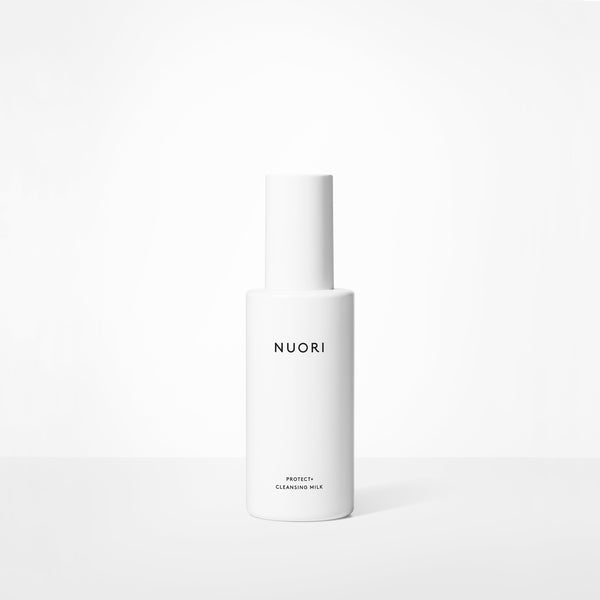
Nuori Protect+ Cleansing Milk
Toning can prime your skin with extra hydration, but only if you choose the right one. Skip anything with alcohol, and instead opt for a hydrating and refreshing supplement to your routine. If you’re used to an acid toner , you’re going to have to retire it for a while on tretinoin. Either way, apply your toner, then wait for it to dry before applying tretinoin. You can also load your skin up with moisture during this step by using a gentle, hydrating essence.

Equilibria Stabilizing Toner
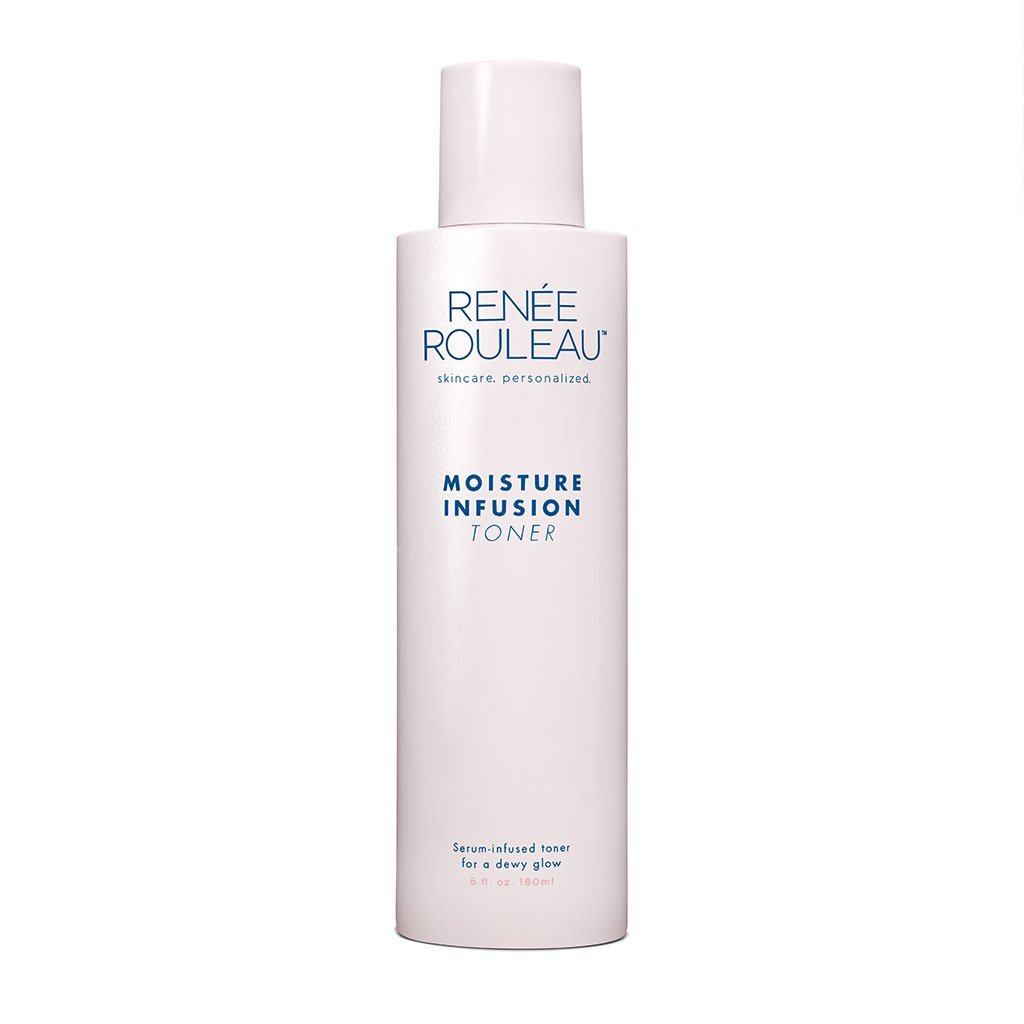
Renee Rouleau Moisture Infusion Toner
To avoid overstimulating your skin while you start tretinoin, most experts suggest saving serums for the morning and using tretinoin at night. Good serums are those that complement the effects of your retinoid. Niacinamide helps soothe irritated skin and protect the skin barrier. Hydrating serums help keep your skin from excessive dryness. And finally, vitamin C serums help facilitate collagen production.
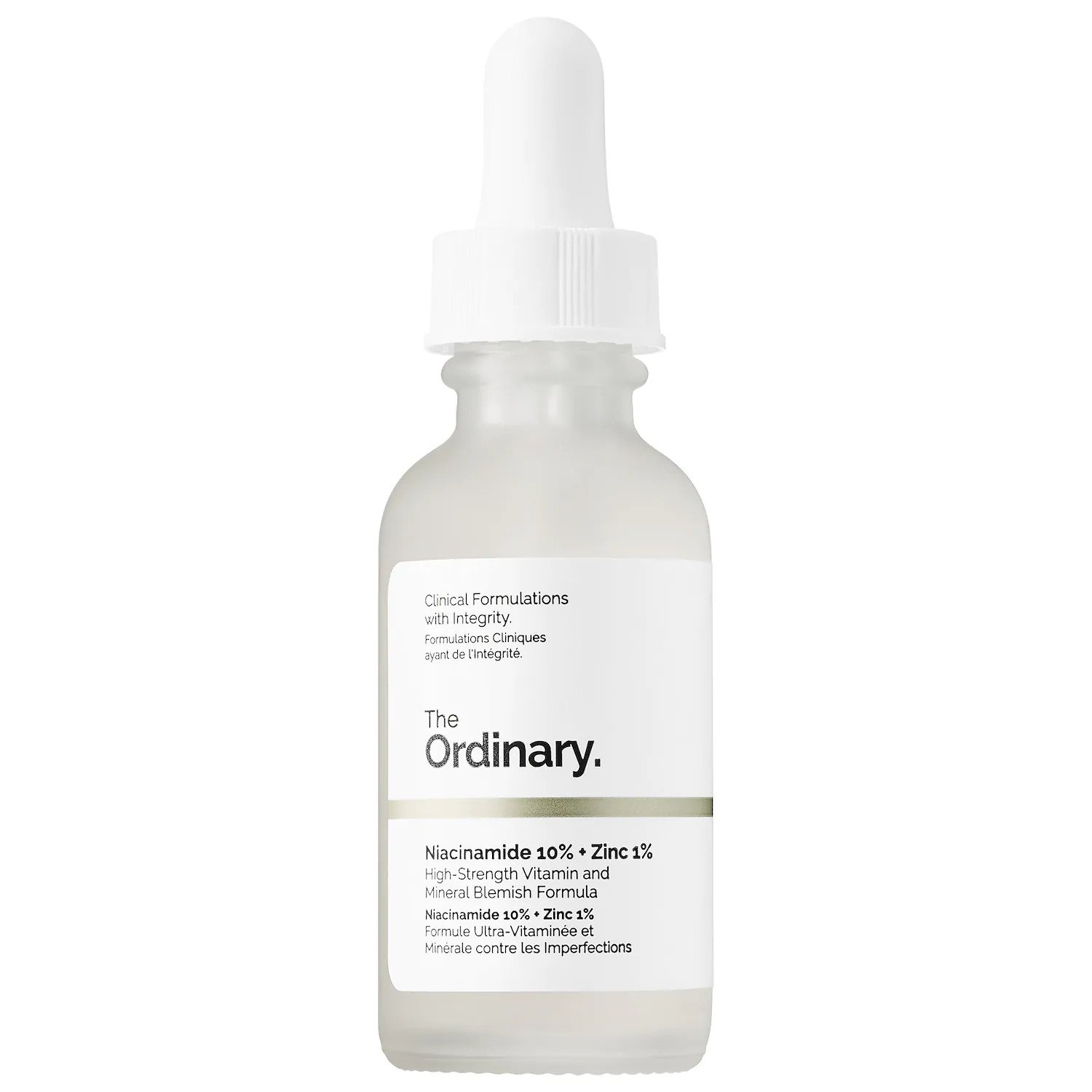
The Ordinary Niacinamide 10% + Zinc 1% Serum
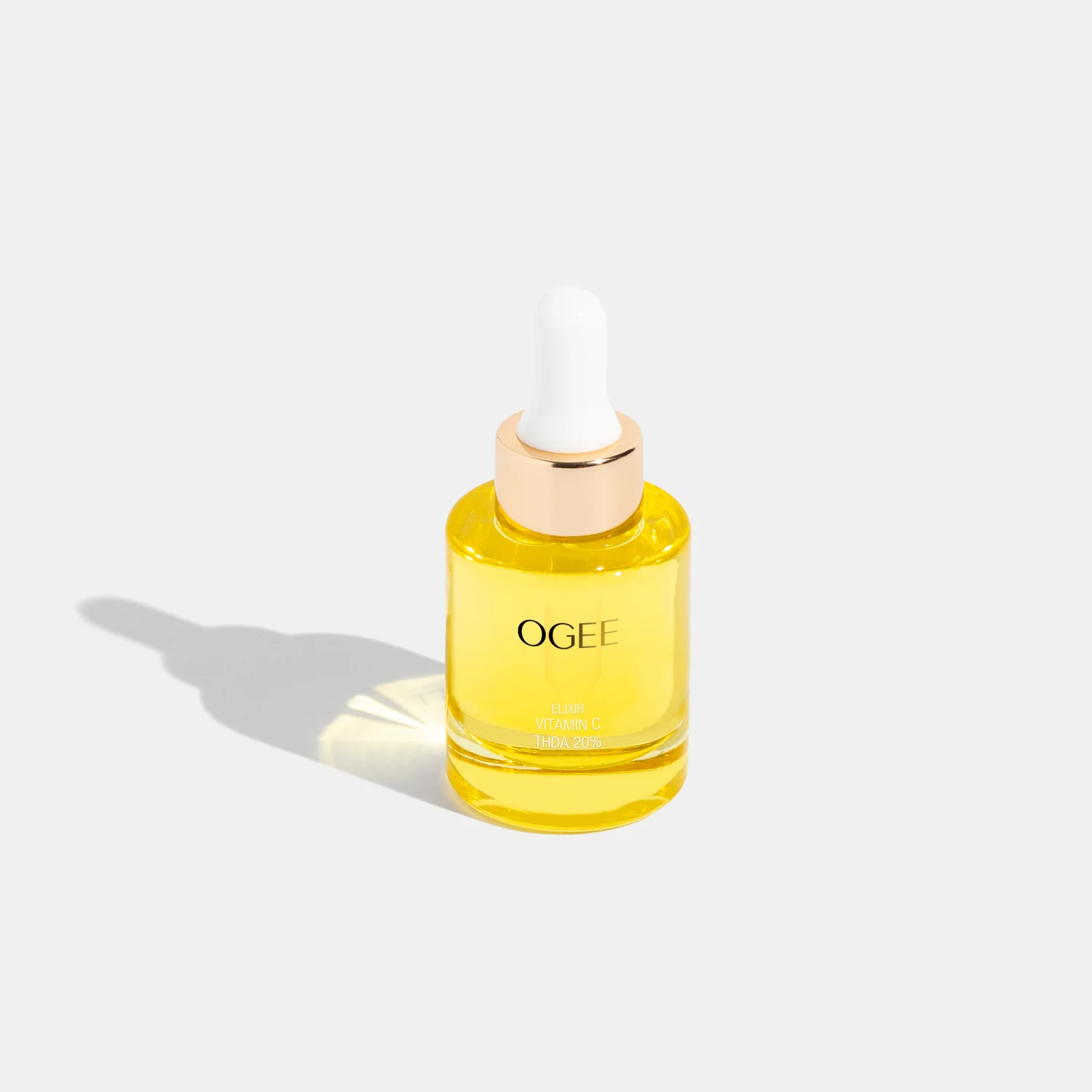
OGEE Vitamin C THDA 20% Elixir
Moisturizer
Keeping your skin moisturized is one of the best ways to minimize the side effects of tretinoin, like irritation and dryness. Experts suggest using a stronger moisturizer when you start with tretinoin while being mindful of your skincare type. If you already suffer from dry skin, you’ll want to use a super-rich moisturizer. If you have oilier skin, you still want to step up your hydrationn game, but it doesn’t have to be as intense. Just make sure you choose products without synthetic fragrances to keep irritation at bay.
When starting out, apply moisturizer directly after applying tretinoin to minimize potential irritation. As your skin adjusts, you can leave tretinoin on for about 20 minutes before following up with a moisturizer.
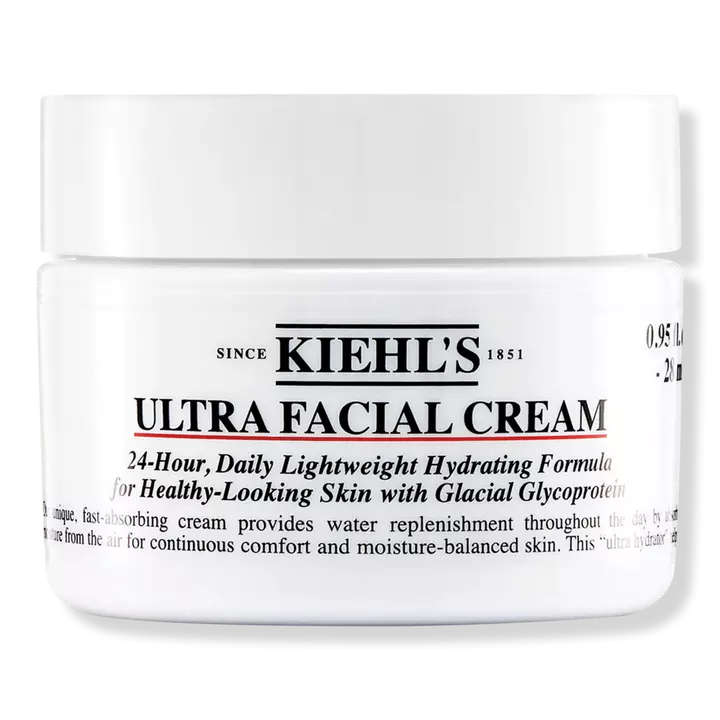
Ultra Facial Cream
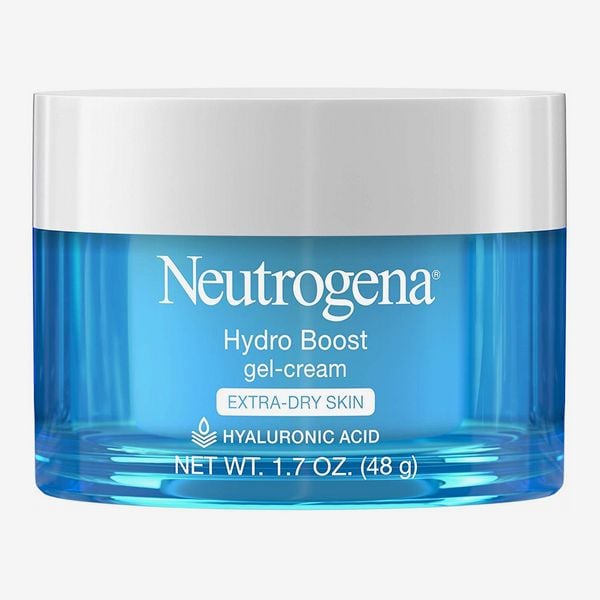
Neutrogena Hydro Boost Water Gel
$20.99 (reg. $29.99)
I cannot express the importance of always applying your sunscreen (liberally!). This is especially true on tretinoin. Retinoids increase your sensitivity to the sun, so any work your tretinoin is doing will immediately be compromised without adequate sun protection. Try clean mineral sunscreens to provide a physical shield between you and the sun. And be sure to reapply throughout the day!
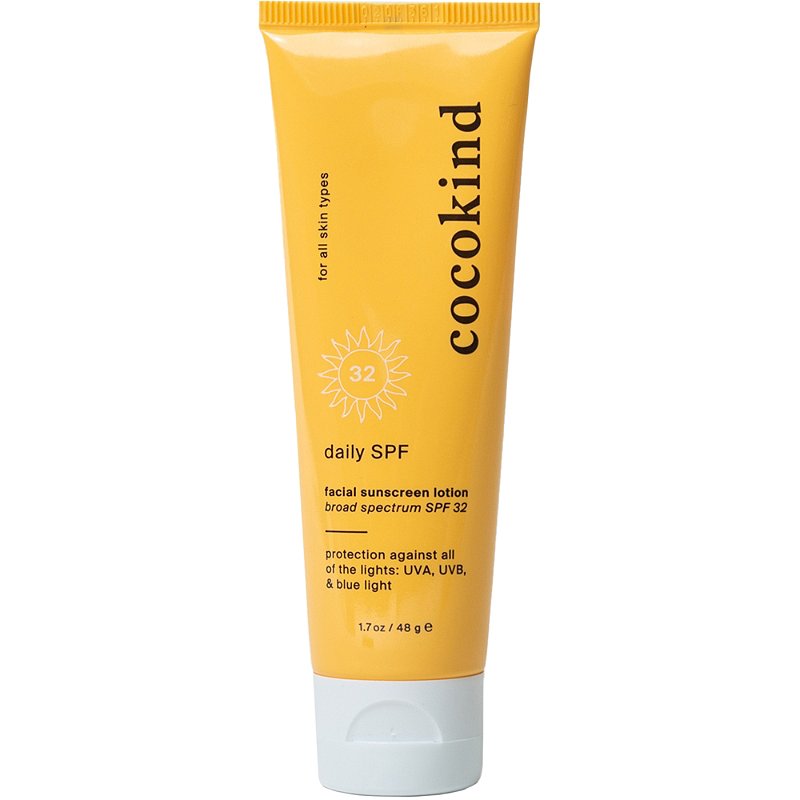
cocokind daily spf

Kari Gran Essential SPF 30
More Like This:

The Surprising Pantry Staple Beauty Experts Swear By for Soft, Ageless Skin
Glowing girl summer.
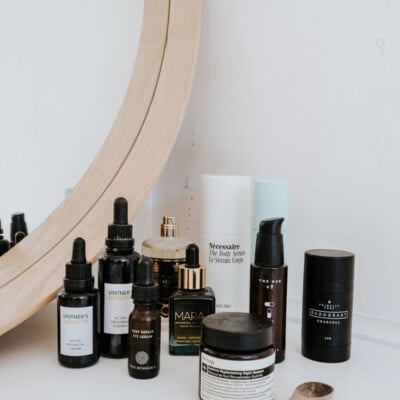
Dermatologists Say This Is the Best Skincare Routine to Minimize Pores
Glass skin for good.
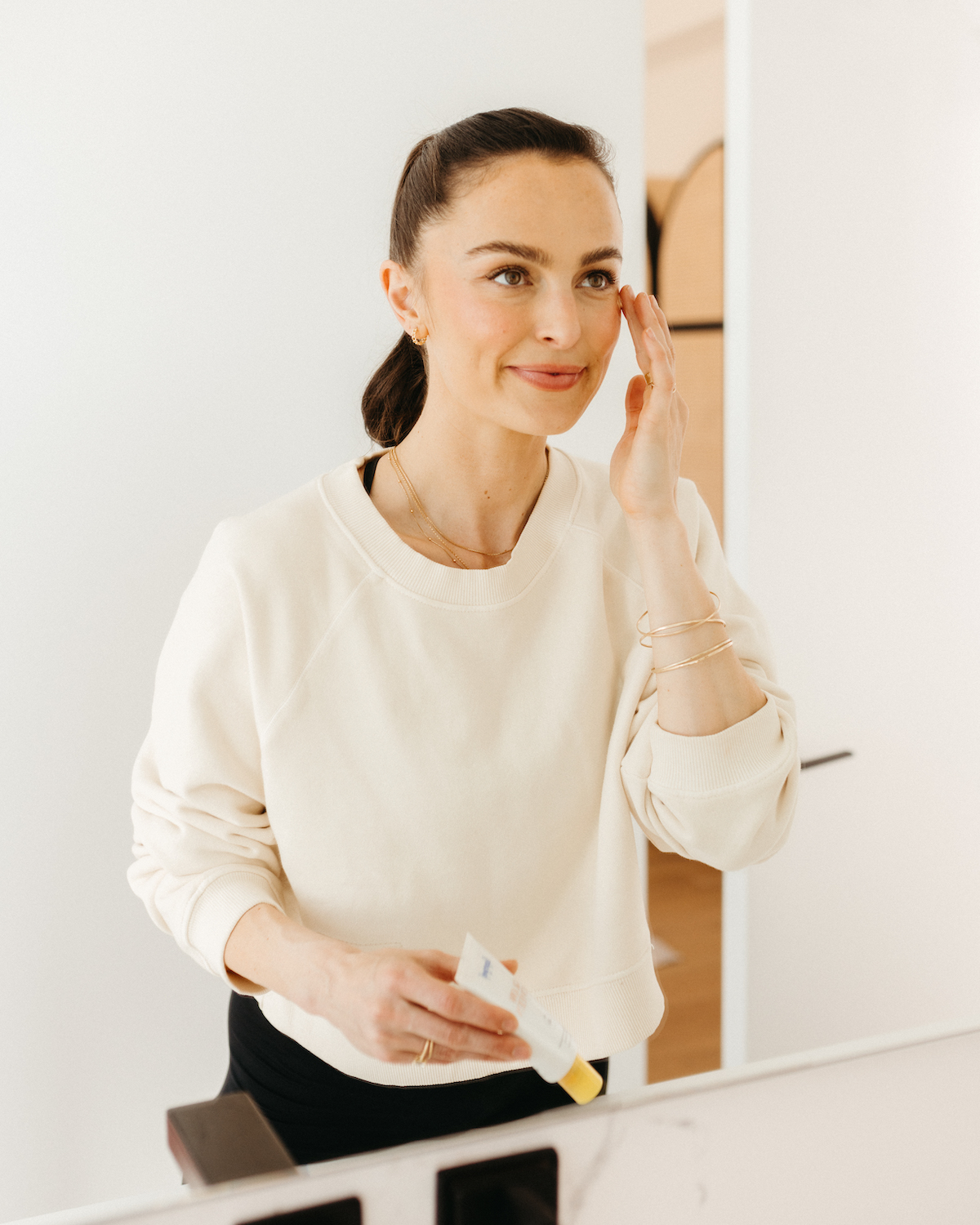
Versed’s New Line Puts Hydration Front and Center—And Everything Is Under $15
Your best skin—on a budget.

The Best Retinol for Every Skin Concern—According to the Pros
Your guide to the holy grail beauty ingredient.
Understanding the Tretinoin Purge: What to Expect and How to Manage It

If you're new to using tretinoin, you may have heard about a phenomenon known as the "tretinoin purge." This can be a daunting prospect, but understanding what to expect and how to manage it can help ease your concerns. In this article, we'll explore the science behind tretinoin, the specifics of the tretinoin purge, what you can expect during this process, and strategies for managing it effectively.
What is Tretinoin?
Before delving into the tretinoin purge, let's first understand what tretinoin is. Tretinoin is a topical medication derived from vitamin A. It is commonly used in dermatology to treat acne, fine lines, wrinkles, and other skin conditions. Tretinoin works by increasing cell turnover, promoting the growth of new skin cells, and improving the overall appearance and texture of the skin .
The Role of Tretinoin in Skincare
Tretinoin is an incredibly versatile skincare ingredient. Its main function is to exfoliate the skin and unclog pores, which can lead to a reduction in acne breakouts. Additionally, tretinoin stimulates collagen production , which helps to improve skin elasticity and reduce the appearance of fine lines and wrinkles over time. It is considered one of the gold-standard treatments for acne and anti-aging concerns.
The Science Behind Tretinoin
Tretinoin works by binding to specific receptors in the skin cells, which activates a series of molecular events. These events lead to increased cell turnover and the shedding of dead skin cells, leaving behind fresher, healthier skin. Tretinoin also helps regulate the production of sebum, the oily substance that can contribute to acne formation.
But what exactly happens during the tretinoin purge? When you first start using tretinoin, you may experience a temporary worsening of your acne . This is often referred to as the "tretinoin purge." It occurs because tretinoin is speeding up the skin cell turnover process, which can bring underlying acne lesions to the surface more quickly. While this can be frustrating, it is actually a sign that the medication is working.
During the tretinoin purge, you may notice an increase in the number of pimples, blackheads, and whiteheads on your skin. This can be accompanied by redness, dryness, and flaking. It is important to remember that this is a temporary phase and that your skin will eventually adjust to the medication.
It is recommended to start tretinoin slowly , using it every other night or every third night, to allow your skin to acclimate to the medication. You can gradually increase the frequency of use as your skin tolerates it. Additionally, it is important to use a moisturizer to help combat dryness and irritation that may occur during the purge.
While the tretinoin purge can be discouraging, it is important to stay consistent with your treatment. Over time, as your skin adjusts to the medication, you should start to see improvements in your acne and overall skin texture. It is also worth noting that the duration and severity of the purge can vary from person to person.
In conclusion, tretinoin is a powerful skincare ingredient that can effectively treat acne and improve the appearance of fine lines and wrinkles. While the tretinoin purge may be a temporary setback, it is a normal part of the treatment process. With patience and consistent use, tretinoin can help you achieve clearer, healthier skin .
The Tretinoin Purge Explained
Now, let's dive into what exactly happens during a tretinoin purge.
When starting tretinoin treatment, it's important to understand that the journey to clear and healthy skin may not be a smooth one. The tretinoin purge is a temporary, albeit frustrating, aspect of this process. As your skin adjusts to the medication, it can initially worsen before improving.
So, what exactly happens during a tretinoin purge? Let's break it down.
What Happens During a Tretinoin Purge?
Tretinoin, a derivative of vitamin A , is a powerful ingredient that works wonders for many skin concerns. It speeds up the skin cell turnover process, which is essential for achieving a fresh and rejuvenated complexion. However, this accelerated turnover can cause existing impurities to rise to the surface of the skin, leading to what is commonly known as the tretinoin purge.
During this phase, you may notice an initial increase in redness, peeling, dryness, and even a temporary increase in acne breakouts. This can be disheartening, especially when you're hoping for immediate results. However, it's important to remember that this is a normal part of the process and a sign that the medication is working.
As the tretinoin purge continues, your skin gradually eliminates the impurities that were lurking beneath the surface. This allows for a fresh start and paves the way for clearer, healthier skin in the long run.
The Duration of a Tretinoin Purge
Now that you understand what happens during a tretinoin purge, you may be wondering how long this phase will last.
The duration of a tretinoin purge varies from person to person. For most individuals, this phase typically lasts around 4 to 6 weeks. However, it's important to remember that everyone's skin is unique, and some individuals may experience a longer or shorter purge period.
During this time, it's crucial to be patient and consistent with your tretinoin treatment. It can be tempting to give up when you see your skin going through a rough patch, but remember that the purge is a necessary step towards achieving the clear and radiant complexion you desire.
While waiting for the tretinoin purge to pass, it's essential to take good care of your skin. Ensure you're using a gentle cleanser, moisturizer, and sunscreen to protect and nourish your skin throughout the process. Additionally, avoid using any harsh exfoliants or other irritating products that may exacerbate the purge.
Remember, the tretinoin purge is just a temporary phase, and with time, patience, and proper skincare, you'll soon reap the benefits of this powerful medication.
What to Expect During the Tretinoin Purge
Now that you have an understanding of what the tretinoin purge entails, let's discuss what you can expect during this phase.
Physical Changes to Expect
During the tretinoin purge, you may notice increased dryness, flakiness, and redness in your skin. It's crucial to keep your skin hydrated and moisturized during this time. Opt for gentle, fragrance-free moisturizers and avoid harsh or drying skincare products that can exacerbate these side effects.
Emotional Impact of the Tretinoin Purge
It's essential to acknowledge the potential emotional impact of the tretinoin purge. Dealing with an initial worsening of your skin can be disheartening, but remember that this phase is temporary. Surround yourself with positive support, practice self-care, and remind yourself of the long-term benefits that tretinoin can provide.
How to Manage the Tretinoin Purge
While the tretinoin purge can be challenging, there are several strategies you can employ to navigate this phase successfully.
Skincare Routines During the Purge
During the tretinoin purge, it's crucial to prioritize gentleness and simplicity in your skincare routine. Use a mild facial cleanser twice a day, followed by a gentle moisturizer and sunscreen with at least SPF 30. Avoid using harsh exfoliants or irritating skincare products that can further aggravate your skin.
Lifestyle Changes to Aid the Process
Supporting your skin's health from within can also aid in managing the tretinoin purge. Ensure you're staying well-hydrated by drinking plenty of water. Follow a balanced diet rich in fruits, vegetables, and omega-3 fatty acids, which can help promote overall skin health. Finally, be patient with yourself. Remember that the purge is a sign that the treatment is working, and your skin will improve over time.
Frequently Asked Questions About the Tretinoin Purge
Let's address some common questions related to the tretinoin purge.
Is the Tretinoin Purge Necessary?
The tretinoin purge is not necessary for everyone, but it's a common experience for many individuals starting tretinoin treatment. It's a sign that the medication is effectively exfoliating your skin and helping to clear out impurities. While it can be frustrating, it's a natural part of the process.
Can the Purge be Prevented or Minimized?
Unfortunately, the tretinoin purge cannot be entirely prevented. However, certain steps can help minimize its severity and duration. Starting with a lower concentration of tretinoin, gradually increasing the frequency of application, and using a gentle moisturizer can help ease the transition and mitigate the potential side effects.
As you embark on your tretinoin journey, remember that everyone's experience will differ. What matters most is understanding the process, being prepared, and adjusting your skincare routine accordingly. The tretinoin purge may be challenging, but it is also an opportunity for your skin to undergo positive transformations.
If you have any concerns or questions about the tretinoin purge, it's always best to consult with a dermatologist or skincare professional. They can provide personalized advice and guidance to ensure you get the most out of your tretinoin treatment.
At Piction Health, we believe that everyone deserves access to quality dermatology care. We offer online dermatology consultations with experienced dermatologists who can guide you through your skincare journey, including managing the tretinoin purge. Book an online consultation with us today and take the first step towards healthier, happier skin.
Check other posts

How to Get Rid of Acne Overnight…The Truth | Piction Health

The 7 Stages of Healing: Cystic Acne | Piction Health

Birth Control for Acne: A Surprising Solution | Piction Health

- Shop With Us

IMAGES
VIDEO
COMMENTS
Doctor's week-by-week guide to what to expect when starting your Tretinoin journey. Timeline for how long Tretinoin takes to work!
In this article, we'll take a chronological journey through the tretinoin purge process and some best practices to get through it. It's all in the pursuit of great, long-lasting results on the other side, and with an effective wrinkle- and acne-buster like tretinoin, it's worth it.
How I finally cured my hormonal acne after 10 years with tretinoin, with before and after pictures.
This video is not sponsored. All opinions are my own and always will be! 6 Month Tretinoin/Retin-A Update: Before & After + My Current Skincare Routine!
Like tretinoin, AzA is a strong medication available only by prescription. Both treat acne — tretinoin has additional anti-aging superpowers, and azelaic acid takes my redness and inflammation down. I've used two different concentrations of AzA before. I found 4% was fine for everyday use.
I'm on week 8 of my trying tretinoin journey. Read on to learn what to expect 2 months into tretinoin use.
Trying Tretinoin: a tretinoin field guide. Follow along while I document week-by-week the start of my Tretinoin journey.
Use code GLOWBYRAMON to get your first visit through Apostrophe for $5: https://www.apostrophe.com/friend/GLOWBYRAMON/?utm_source=influencer&utm_medium=youtu...
This enhances your tretinoin usage experience, reduces potential skin damage, and makes the journey smoother and more beneficial in the long run. Learning to discern these signals and responding accordingly is vital for beginners embarking on their tretinoin journey.
In this video I'll be sharing my 9 month results using Tretinoin, chatting through a month by month timeline, and covering lots of tips for clear skin!#treti...
What is Tretinoin? For the newbies, tretinoin is " a vitamin A derivative, a type of retinoid that is available as a prescription," explains Marisa Garshick, MD, a board certified dermatologist based in New York. The workhorse ingredient works by regulating skin cell turnover and can help prevent and treat acne, explains Dr. Garshick.
So, before you begin your tretinoin journey, equip yourself with our tips and tricks to get the desired outcome from the treatment. This article will detail how tretinoin works, how best to use it, and what mistakes you need to avoid to see effective results.
All you need to know about this popular retinoid, like how to use tretinoin in your daily routine (plus the best products!).
If you're new to using tretinoin, you may have heard about a phenomenon known as the "tretinoin purge." This can be a daunting prospect, but understanding what to expect and how to manage it can help ease your concerns. In this article, we'll explore the science behind tretinoin, the specifics of the tretinoin purge, what you can expect during this process, and strategies for managing it ...
Retinoids, or retinol, are what we have previously referred to as tretinoin. Retinoic acid-containing creams are typically used to treat inflammatory skin diseases of the face and body, including ...
Join Me on a Personal Journey to Clear Skin: My Tretinoin Story00:00 intro00:33 my acne story03:50 why do I film tretinoin update every week?04:22 how often ...
We asked a dermatologist everything you want to know about using tretinoin: when to apply it, how often, how much, and how to layer it.
My Tretinoin Journey: From damaged skin barrier to healthy, improving skin. All the famous Youtube skincare-gurus use it. Dermatologists seem to recommend it. And there's probably a person or two in your vicinity that's either using Retinol or thinking about using it. Retinol almost sounds like the perfect cure for all things anti-aging.
A dermatologist explains what tretinoin does, how to use it, and common side effects. Plus, read an editor's experience with the product.
pm tretinoin skincare routine OUT NOW: • pm skincare routine *tretinoin* thank you so much for watching, I hope my tips helped! let me know if you have any questions below xx business inquires ...
Here are pictures of my journey + my routine and what wisdom was offered to me by angels in this sub which I want to return to others <3 My skin is still healing, but its looking better than it has in years thanks to tret and finding my routine. So far: Routine: AM: - Cleanse: 1 whole minute - Vanicream moisturizing cleanser.
I wanted to share my tretinoin before and after results and everything in-between. I embarked on my tretinoin journey in September 2019 and used it up until May 2020 (8 months).
Tretinoin is a prescription-based product and has to be prescribed by a health care professional. Tretinoin is also known as retinoic acid, all trans-retinonic acid or Tret. It's available in 3 different strengths. The strength that is prescribed is dependent on a few factors like your age and skin condition.